|
BIOGRAPHIES
Source:
ILLUSTRATED
ATLAS & HISTORY
of
HARRISON COUNTY, INDIANA
containing maps of
Villages, Cities and Townships
of the County,
Maps of State, United States and World.
County Statistics, Biographies and History of the County
Portraits of Public and Leading Citizens
Compiled and Published by
F. A. Bulleit
Cordon, Ind.
1906
<
CLICK HERE to GO to LIST of TABLES of CONTENTS and BIOGRAPHICAL
INDEXES >
|
Pg. 49 - Industrial Review,
Biographies and Portraits of Leading Citizens. |
George K. Gwartney was
their attorney and received from them two shot guns in
payment of his fee. Certain men upbraided Mr.
Gwartney for being instrumental in their release and
intimated that justice would be given them by some other
method. Mr. Gwartney replied that he had
only done his duty as an attorney and was now going to
do his duty as a citizen of Harrison County - he was
going to return their guns to the Conrads.
Shouldering their guns the Conrads returned
home. It was not long until they heard the clatter
of horsehoofs and the barking of dogs at night which
betokened that the White Caps were holding councils.
When their
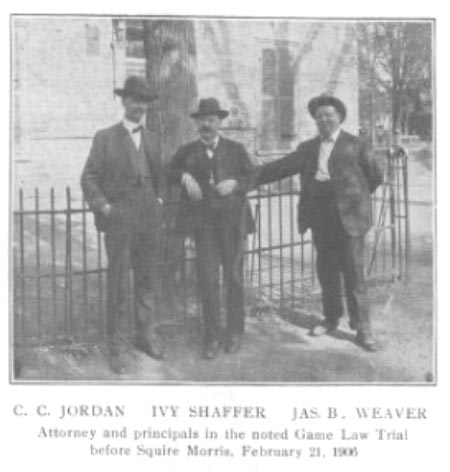
C. C. JORDAN IVY SHAFFER JAS. B. WEAVER
Attorney and principals in the noted Game Law Trial
before Squire Morris, Feb. 21, 1906.
own dog was mysteriously poisoned they realized that
something would soon occur i their hollow and they moved
their beds to a secreted place in the hillside three
hundred years distant from the cabin. They were
fully awake and ready for the fray when the White Caps
appeared.
Secreting themselves behind a picket fense within ten
feet of the house, they awaited the coming of the
Regulators. Their opportunity came when, after
they had thoroughly searched the house, a large body of
the
|
- tion in Nicaraugua and when the war ended in
1857 he was in command of a battalion and one of
eighteen left of the original three hundred and
eight-five. In 1858 his father and brother
Charles were thrown into prison in Brandenburg,
Kentucky on a charge of attempting to run off some
slaves. Under existing conditions between
North and South there was no hope for their release.
Horace and his brother John were called home
from California. They planned a daring scheme
of delivery. On a day when most of the
citizens of Brandenburg were absent at a picnic,
they crossed the river, entered the jail and
demanded the keys of the cells where the father and
brother were confined. Liberating and
|
Mattingly and T. C. Slaughter. From
Lanesville were appointed Samuel Tresenriter,
Theodore Day, Samuel Pfrimmer, W. A. Mills, T. S. Gunn,
and Robert Benson.
On July eighth the Plank
Road Company was organized. The directors from
Corydon were Carter Likens and Benjamin P.
Douglass, and from Lanesville, Robert Benson.
A call for two dollars on every hundred subscriptions
was made and the road begun. A second call of two
dollars was made September, 1851, payable to S. J.
Wright, but the road was not completed until after
1853.
Frederick Leslie established a hack line going
up town on Monday. |
|

DISTANT SCENE OF LANESVILLE. |
arming them, all four passed quickly to their boat and
were half way across to Indiana before the escape was
discovered and themselves hailed. Horace
stood up in the boat, a revolver in each hand, and fired
at his pursuers, some of the balls burying themselves in
an old blacksmith shop on the shore.
In the fall, while visiting the Fair at New Albany, he
was captured by officers and taken to Brandenburg to
jail. Two boat loads of citizens of New Albany and
vicinity followed, determined on his rescue.
Excitement ran high in those days and trouble was only
avoided by the wise counsels of the New Albany lawyers.
He returned to California in 1860, but almost
immediately came back to Indiana in time to join the
Sixth Indiana Regiment at Camp Morton. He was
mustered out as major, April eighteenth, 1866. In
December, 1862, Major Bell was married to Miss
Georgia Herrick, a girl of seventeen who went with
him to his field in the very storm belt of the Rebellion
in and around New Orleans. After the war he went
overland to Los Angeles and took up the practice of law.
He now lives with two unmarried daughters in a handsome
home in Berkeley, California. |
returning Wednesday and up again Thursday, returning on
Saturday. This was in order to give the people
time to do their shopping and return. In 1852
Philip Conrad, driver, changed the time going to New
Albany, Monday, Wednesday and Friday and returning on
the intervening days; names to go on next trip were to
be left at J. M. Miller's.
Mr. Martin Hanger, who lived seven miles from
New Albany, furnished The Ledger of that city an account
of travel over the road for six days, beginning first
Monday in September: forty-four-horse wagons, nineteen
three-horse wagons, eighty-six two-horse wagons,
forty-seven one-horse wagons, thirty-seven buggies,
seventy-four horsemen. Two days it rained
incessantly. From these numbers it was inferred
the road would pay. This road is now owned by
Hon. Lewis Jordan of Washington City and heirs of
S. L. Wright.
THE FIRST
RAILROAD.
The first railroad came into
Corydon November twenty-seventh, 1883 (Thanksgiving
Day). It was built largely through the efforts of
S. J. |
|
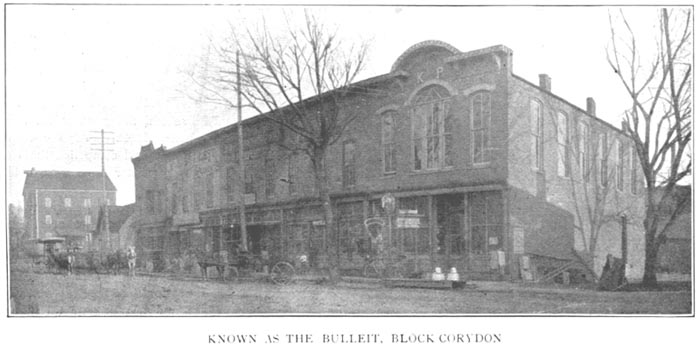
KNOWN AS THE BULLEIT BLOCK, CORYDON |

OAK STREET, CORYDON |
|
White Caps appeared on the porch facing the position
occupied by the two vigilant brothers. There were
gun shots in quick succession and five men fell mortally
wounded. the other White Caps precipitately fled.
It was not until eight o'clock Sunday morning that
anyone could be induced to go into the hollow and make
investigation of the tragedy. In the meantime the
Conrad's had crossed the river at a point four
miles distant and disappeared in Kentucky.
The Coroner returned a verdict that Edward
Huston, Lewis Wiseman, William May, John
Timberlake and Alfred N. Howe came to their
death by gunshot wounds inflicted by Samuel and
William Conrad.
This is the last attempt at White Capping in
Harrison County. It is not at all probable that
there will ever be a repetition of the brutal acts that
made the county so notorious.OTHER
EVENTS
On Sunday, July
tenth, 1864, John H. Lohmeyer shot and killed
Colonel John Timberlake at a church near Mauckport.
Lohmeyer was cleared on plea of self defense.
Claiborne Shuck, Sheriff of the county, shot and
killed Gideon Heth, Marshall of Corydon on Market
Street November second, 1892. Shuck was
tried before Justice R. S. Kirkham and acquitted
on plea of self defense.
Martin Alexander (colored) attacked and shot
William H. Brown (colored) in Brown's own
home on January twenty-second, 1894. Alexander
was tried in court and sentenced to life imprisonment.
He died in the northern prison in Michigan City.
September twenty-sixth, 1896, Andrew White
(colored) killed James Yeager on the
street in Corydon. White was sent to the
reformatory and afterwards paroled.
A DARING RESCUE
Horace Bell was born
in New Albany, December eleventh, 1830, of Revolutionary
stock on his mother's side. When he was two years
old the family moved to Harrison County just above
Mauckport. He attended a private school in
Kentucky, his last teacher being Norman J. Coleman, our
first Secretary of Agriculture.
In 1849, in quest of gold and adventure, he went with
many others to California. In January, 1856, he
joined the Walker army of occupa- |
THOROUGHFARES
It is a curious fact that
opposition has, at all times, marked the advance of good
roads. When a wagon road became a necessity there
were many who placed obstacles in the way of building
it. In 1825 the best a wagon could do was twelve
miles a day. when the capital was moved to
Indianapolis, a distance of one hundred and twenty-five
miles, such was the state of the roads and the streams
that it took ten days to perform the journey in a wagon.
Previous to 1840 Judge Porter road on horseback
to the Legislature in Indianapolis to Madison, he
travelled on it as far as Madison, took a boat from
there to Louisville and procuring a horse rode the rest
of the way home, exciting great wonder at the rapidity
of his journey, which had occupied three days.
At one time the Postmaster at Indianapolis and the
Auditor of State, after a day's travel, as they thought,
toward Cincinnati, paused in wonder at evening at their
own town, which at first, they supposed was some unknown
settlement. Travellers usually used strong wagons
with canvas tops. They would stop at night, cook
supper, feed the horses and sleep in the wagon.
The public travel was done in stage coaches, clumsy and
rocking, with four horses attached. The men inside
were always order out to walk up the hills.
In 1836 and 1837 the mail for Corydon was part of a
stage route from New Albany to Leavenworth, daily.
The merchants of the town made yearly or half yearly
trips in wagons to New Albany to buy goods, over an
almost impassable road.
The New Albany and Vincennes turnpike road running
through Palmyra was built in 1841.
The subject of a plank road from Corydon to New Albany
was agitated and the first meeting to discuss the matter
was held in Corydon, June second, 1851, and attended by
citizens of New Albany, Lanesville and Corydon.
The citizens of Harrison County subscribed five thousand
one hundred and fifty dollars. Persons from New
Albany subscribed five thousand one hundred dollars and
pledged themselves that New Albany would furnish
twenty-five thousand dollars. Committees were
appointed to solicit subscriptions of stock. Those
appointed from Corydon were Joseph Denbo, Paul Seig,
Samuel J. Wright, Arthur Vance, Ignatius |
Wright, Thomas McGrain and S. M. Stockslager.
The contract stipulated that a train should pass over
the road by that date, accordingly, a small engine and
one coach made its way very gingerly over the road,
bearing the directors and a few friends. It
started from Louisville at nine-o'clock and reached
Corydon about two o'clock in the afternoon, and almost
the entire town was at the terminus to meet and welcome
it.
This railroad has been the subject of endless jokes,
nevertheless it has also been of endless benefit to the
town and does a very great
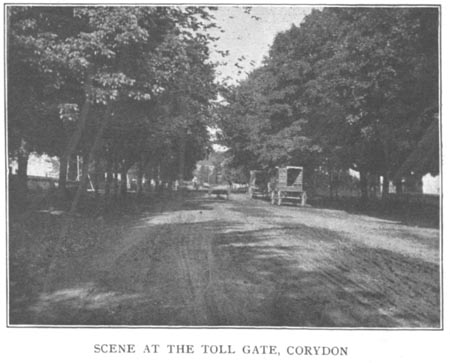
amount of traffic. We take the
following as part of an article which appeared in the
Indianapolis News: "There is a railroad in this
state on which the regular fare is five cents a mile and
even at that it does not make a great deal of money.
This road is the Louisville, New Albany & Corydon,
extending from Corydon Junction on the Air Line to the
town of Corydon eight miles away. The road is a
series of inshoots and outshoots, up curves and down
curves and the rails weigh from thirty to forty pounds a
yard. |
|
Pg. 50
- Industrial Review, Biographies and Portraits of
Leading Citizens. |
"The equipment consists of one
engine and a coach that is fashioned like a street car,
one flat car and the freight cars furnished by the Air
Line. The engine pushes or pulls the one car over
the road six tiems a day to connect with trains on the
Air Line.
There is at no time any danger of a collision for it is
the only train on the road. There is one bridge on
the line and that is very substantially made. The
conductor is one of the old school who takes tickets and
collects cash fares at five cents a mile and in summer
does not wear any coat, collar or cuffs. The train
stops at 'any old place' and always leaves the town on
time, but there is no real certainty of its getting back
on time. M. J. O'Conner fills all positions
in the transportation department from general manager to
train dispatcher.
"He is also the entire traffic department, and all
matters concerning the maintenance of the road from
chief engineer to section boss is attended to by him.
He is also the mechanical department and all other |
Slaughter was President and
James H. Shields was Cashier when it was opened.
The county was disturbed with political and war
excitement and this bank never did much business.
In 1862 James Shields resigned as Cashier and was
succeeded by his father, Henry B. Shields.
the Morgan Raid occurred and the banking office
was visited by one of the rebel officers, but as its
funds had been taken temporarily to New Albany for
security against capture, he got nothing out of it.
Such a troublous state of affairs led to a conclusion to
wind up the Bank of Corydon, which was done in the
latter part of 1864 or first of 1865. Nearly every
dollar was presented and redeemed.
George W. Applegate established the Bank of
Corydon in August, 1880. W. B. Slemons,
Cashier. This was merged into the Corydon National
Bank, July first, 1905, with the same officers.
The First National Bank was established April second,
1903, with J. M. Andrews, president, and V. J.
Bulleit, Cashier. |
marched as far as Peter
Glenn's, four miles south on the Mauckport road.
Several small skirmishes occurred between these troops
and the enemy. A body of rebel cavalry
dismounted at Glenn's house and shot
John Glenn, who appeared on the porch with
his gun in his hand. They decoyed his father,
Peter Glenn, to the house by a white flag.
Mr. Glenn before the war was accustomed to
preach at many points in Kentucky. In some of
these sermons he took occasion to bitterly denounce the
institution of slavery, and for this reason incurred the
displeasure of many of the slave owners of that section
of Kentucky. It is reported that some of
these men were with Morgan and that they had
Mr. Glenn marked, and had decided to kill him.
As the Home Guards came up the rebels rushed for their
horses. One man could not loosen the halter of his
horse quick enough, and Mr. Glenn, who saw his
son lying wounded and his barn burning, took down his
gun and shot this man, thus sounding his own death
knell. The rebels killed him and burned the nice
farm house in which he lived. They had previously
burned Peter Lopp's mills on Buck Creek.
Corydon was a scene of excitement that Wednesday night.
Everybody expected the town to be sacked and burned.
The few remaining men were busy hunting supplies and
ammunition for the Home Guards already out on duty, and
spiriting away valuable horses. The women flitted
everywhere, hiding valuables and rendering such
assistance as was in their power. The night was
moonlight but foggy and weird looking, and through this
shadowy atmosphere the figures of men and women looked
like ghosts. The writer remembers forming one in a
procession which bore a small box containing watches,
silver spoons and family heirlooms, to the far off
garden and there, under the widest spreading current
bush burying the box deep from mortal eye. The few
sick people were moved to places of safety and none but
children slept.
About half past eleven o'clock Thursday morning scouts
brought the report that the enemy was approaching in
strong force up the Mauckport road, toward Corydon.
Our forces, consisting of four hundred and fifty Home
Guards and citizens under command of Colonel Lewis
Jordan of the Legion, assisted by Provost Marshal
Timberlake (late Colonel of the Eighty-first Indiana
Regiment) and Major J. S. Pfrimmer, who up to
this time had been engaged with the cavalry in scouting,
formed a line of battle on the hill one mile south of
town, the extreme right wing resting at the Amsterdam
road and the left near the Laconia road, making the
Mauckport road one-third of the distance from the right
wing. Temporary breastworks composed of logs and
fence rails were hastily thrown up, which did good
service in impeding the charge of the enemy.
About an hour later the enemy made an appearance in
small force in front of the Home Guards and were bravely
repulsed by the infantry, under the command of
Captain G. W. Lahue. In that fight Mr.
Steepleton was killed. The rebels had several
killed and six or seven wounded. Before this
skirmish was fairly over the enemy appeared in front of
our main line along the Mauckport road, in strong force.
They completely filled the road for nearly one mile.
The "Henry Rifles", under command of Major Thomas
McGrain, opened fire and did good work, the enemy
being in full view. Soon the fire became general
along the entire right wing, which checked the advancing
columns and compelled them to flank both our wings at
the same time. Their greater numbers enabled them
to do this easily.
The rebels then opened up with three pieces of
artillery, which made it necessary for our men to fall
back. The fight then became a series of skirmishes
in which each man seemed to fight on his own hook.
In the meantime the enemy had taken possession of the
plank road one mile east of town. On the right
wing a large flanking force was sent against our lines
and the fighting was very sharp for the space of twenty
minutes in that quarter; twelve Henry Rifles and a squad
of thirty or forty, a hundred yards to their left, armed
with the ordinary rifle musket, holding a heavy body of
flankers in check for ten or fifteen minutes and
compelling them to dismount.
Being completely overpowered by numbers our forces
gradually fell back to Corydon and most of the cavalry
and mounted infantry made their escape. The rebels
planted a battery on the hill south of town and threw
two shells into town, both of them striking near Market
Street. |
|

STREET SCENE IN NEW AMSTERDAM
|
departments and in order that his titles may not get
mixed he is generally spoken of as 'the old man'.
"St. John Boyle, a prominent lawyer of
Louisville, is vice president of the road and has charge
of the legal department. 'Bob' Tracewell,
controller of the United States treasury, is the board
of directors. It is the only road that runs into
Corydon and some day will be put in good shape, it is
asserted. the capital stock of the company is
$145,000 and it has outstanding a considerable amount of
bonds due in 1918. Those who have travelled the
road many times say it is the only one of its kind in
the State.THE CORYDON BAR
In the early days of the
territory and State when there was much litigation,
there gathered about Corydon, the capital, a brilliant
galaxy of legal talent that has perhaps not been equaled
since. The names of many who then practiced at the
bar have come down to us as the brightest lights the
State has ever known. After Corydon lost the
Capital to Indianapolis the attorneys practiced in both
places and at many other points in the State, going the
rounds of the large circuit on horseback, through
tangled thickets and over muddy roads and swollen
streams with "leggings" on and saddle bags beneath
them. The writer of this remembers being aroused
at night from childish slumbers by the arrival of her
father and his friends after weeks of absence, and the
subsequent aroma that arose from frying bacon and eggs
as the women of the household prepared a midnight supper
for the belated travelers.
Benjamin Parke, afterwards United States
District Judge under President Madison, seems to
have been ubiquitous. His first case was a trial
of a young man for stealing a twenty-five cent pocket
knife. He rode all the way to Wayne County to try
this case, the only one on the docket. The Judge
sat on a log, the court being held in a forest.
Other names are Ratliff Boon, General W. Johnson,
Thomas Randolph, Attorney General of the Territory,
Harbin H. Moore, Reuben W. Nelson and Henry W.
Coburn. The first session of the Supreme Court
was held at Corydon May fifth, 1817, and was composed of
three judges, namely, James Scott, John Johnson,
and Jesse L. Holman.
Judge Dewey, a bosom friend of Benjamin Parke,
sat on the Supreme bench eleven years. He was in
the front rank of Indiana judges. He moved to New
Albany and as late as the fifties he argued cases in the
old Corydon courthouse.
Robert A. New, first Secretary of State,
George F. Pope, first Clerk of Circuit Court,
Henry P. Thornton, A. P. Willard, W. T. Otto, Judges
Bicknell, Porter and Slaughter, John W. Payne, W.
Q. Gresham, Samuel Keen, S. M. Stockslager, S. K. Wolfe,
W. N. Tracewell, R. J. Tracewell, Geo. W. Self are
only a few names among the many on the long illustrious
roll. At present C. W. Cook is on the bench
, associated with the following attorneys:
William Ridley, Major W. Funk, Henry Richards, William
Roose, Congressman W. T. Zenor, Clay Hayes, Emery
H. Breeden, Abner Hunter, Frank Self, T. S. Jones, E. D.
Mitchell, Clarence Jordan, T. J. Wilson, R. S. Kirkham,
George Gwartney and Lewis O'Bannon.
HARRISON COUNTY BANKS
In 1814 the general assembly of Indiana granted
charters to two banking institutions, The Farmer's and
Mechanic's Bank of Madison and the Bank of Vincennes.
The latter was authorized to raise a capital of five
hundred thousand dollars. This bank had a branch
at Corydon in 1821.
There is no record of any other bank in Corydon until
1857. On the first Monday of August of that year
the Bank of Corydon went into operation with a capital
stock of fifty thousand dollars, divided into five
hundred shares. W. C. Depauw held three
hundred and ninety-nine of these shares. W. C.
Depauw held three hundred and ninety-nine of these
shares. Thomas Posey was President of this
bank and B. P. Douglas, Cashier. Other
stockholders were Arthur Vance, Edward C. Powers,
Benjamin Wendell, G. A. Harbaugh, J. L. Menaugh, S. W.
Douglas, Joseph Pollock, George W. Denbo, and
John L. Bates.
In November, 1860, another
Bank of Corydon commenced business. Samuel J.
Wright, Robert Leffler, and T. C. Slaughter
of Corydon and James R. Shields of New Albany
were stockholders and directors. T. C. |
THE MORGAN RAID.
During the
war of tide of battle surged up close to the Ohio River,
and often the old court house bell rang out an alarm and
people gathered on the street corners, believing the foe
was right upon us. We were thus somewhat prepared
when on Tuesday, the seventh of July, 1853, the dreaded
John Morgan appeared at Brandenburg with
his face turned toward Indiana.
What follows in this account is taken very largely from
the article in the Corydon Democrat of July fourteenth,
1863, written by its editor, S. K. Wolfe, and
furnished to the writer by Mrs. Agnes M. Jordan.
It is mixed with personal recollections from various
sources which might be multiplied indefinitely captured
by Morgan's advance guard then in possession of
the town. The McCombs was taken by the rebels to
the middle of the river and there she hoisted the sign
of distress. Soon after, the Alice Dean
coming up was hailed to give relief. For that
purpose she approached the McCombs and was thus
also captured by the rebels. The news of the
capture of these boats was communicated by some Union
men of Brandenburg to Lieutenant Colonel William J.
Irvin of the Indiana Legion, then at Mauckport.
A short time after receiving this intelligence, the
Lady Pike coming up was hailed by Colonel Irvin
at Mauckport and turned back to Leavenworth for a six
pound gun and assistance; a dispatch was also sent to
Colonel Jordan for reinforcements. At midnight
the Lady Pike returned with the Leavenworth gun and a
small company to man it under command of Captain
Lyons and Colonel Woodbury.
The fog prevented any action until Wednesday morning,
the eighth. A confusion of orders here occurred
which has never been satisfactorily explained.
Colonel Irvin gave orders to fire on the boilers of
the boats, which order he says was countermanded by
Provost Marshal Timberlake, who claimed precedence
and who ordered the gunners to fire on the
|
|

DISTANT SCENE OF ELIZABETH
|
rebel cavalry on the bank. Soon, however, two
rebel batteries, one at the Court House in Brandenburg
and the other toward the lower part of town, began to
play with terrific force upon our guns with shells,
making it too hot for our boys to hold their position.
Under cover of these batteries the enemy began to cross
their forces to the Indiana side. About one
hundred men under Captains Farquar, Hays and
Huffman met, them and opened up fire briskly,
holding their ground as long as it was prudent to do so
in face of such a superior force. When they fell
back they left Jeremiah Nance of Laconia dead on
the field and James Current of Heth township
mortally wounded, to whom Capt. S. M. Stockslager
was carrying water in his hat.
The only thing that could be done was to hinder the
march of the rebels as much as possible until
reinforcement could arrive or General Hobson, who
was in pursuit, could come up. No help came from
New Albany where government troops with artillery were
stationed, although dispatches were repeatedly sent
there for help.
Nothing daunted, the Home Guards, with Colonel
Jordan at their head, gathered a force of three
hundred men on Wednesday evening and |
One exploded but did no damage. Seeing the contest
was hopeless, and that a continuance of the fight would
only result in unnecessary loss of life and the
destruction of the town, Colonel Jordan wisely
hoisted the white flag and surrendered.
"General Basil Duke, in his history of Morgan's
Cavalry, places the number of militia at four thousand
and says 'they defended their rail piles manfully'.
The defense must have been very creditable indeed, if a
brave, veteran officer like Duke could see four
thousand men where only four hundred stood. The
War Department recognized the importance of this
engagement by inserting the name of "Corydon" in the
official list of battles of the Civil War." - (Henry
Jordan.)
The rebels seized Honorable S. K. Wolfe, State
Senator, and Samuel W. Douglass, County Auditor,
who were out with the Henry Rifles, and required them to
ride at the head of their column, declaring that if they
(the rebels) were shot at on entering town they would
shoot the two gentlemen named.
When the firing ceased, the writer heard that an old
man was wounded on the hill and thinking that it might
be her father, who was with the |
|
Pg. 51 - Industrial Review,
Biographies and Portraits of Leading Citizens. |
Henry Rifles, started with a girl companion, Mary
Mitchell, for the scene. With a courage born
of ignorance, we sped through the street in front of the
fair ground, and at the foot of the hill, just this side
of Dr. Lawson's house, we confronted a group of
officers who had stopped under the shade of a tree and
were wiping their perspiring faces. We were at
once halted and asked our business. We told it,
when one of them called an aid and gave us in charge and
we started up the Mauckport road, then a very steep and
rocky hill.
The rebel troops were clattering down - artillery and
cavalry filling the whole road. For almost a mile
we gazed in wonder, pressing close to the fence as they
cheered our guard who rode silently beside us. We
reached what was then the McBride farm, and
entering the house found the surgeons attending the
wounded man. It proved to be Colonel Ferree,
who afterwards died of his wounds.
Our guard had galloped back to town but the road was
deserted and we hastened back, to find the rebels in
complete possession. The two stores of Douglas,
Denbo & Co. and S. J. Wright were robbed
of about three thousand dollars each. The drug
store of Dr. Reader and several other
establishments were also relieved of portions of their
contents. A contribution of five hundred dollars
each was levied upon the two mills in town, owned by
Leffler & Applegate and Wright & Brown, to
save their mills from the flames. A like sum
was levied on Mauck's Mill near town, which
Harbin Applegate and Samuel J. Wright
paid in the absence of John J. Mauck. Few
citizens escaped loss either of horses or property.
They robbed Mr. Misey, Treasurer of seven
hundred fifty dollars, stole all the clothing of
Judge F. W. Matthis except what he had on, and a
pair of fine boots from B. P. Douglass.
They entered private houses and demanded victuals,
eating all that the ladies had prepared for the Home
Guards.
The Court House square was filled with Union prisoners,
about three hundred, all of whom were paroled. Our
killed were William Heth, who was shot at the
toll gate, Nathan McKinzie and Harry
Steepleton. The wounded: Jacob Ferree
and Caleb Thomas. The rebels admitted their
loss to be eight killed and thirty-three wounded; among
the latter were a Major, a Captain and three
Lieutenants. The Presbyterian Church was
used as a hospital for the rebel wounded.
General Morgan remained in his room at the
Kintner House, sleeping most of the time. |
purpose of drilling, during the
winter of 1860 and '61. Our drill room was on the
second floor of the old Court House. Upon the call
of the government for soldiers for three months'
service, the membership of this company was increased by
enlistment to about three hundred. Henry Jordan
became Captain, W. T. Jones, First Lieutenant,
and Alanson Stephens, Second Lieutenant.
"On April twenty-third, 1860, we all left Corydon in
wagons en route for Indianapolis via Jeffersonville.
We arrived at Indianapolis via Jeffersonville. We
arrived at Indianapolis late at night of the same day we
left Corydon and went into Camp Morton the next day,
where we remained until May eleventh, when, from the
fact that all the regiments which were then being
organized were full, there was no room for our company
and we returned home, after being mustered into the
State's Militia. Upon our return home the company
disbanded. Many enlisted in the Seventeenth
Indiana and other regiments for three years. I
enlisted in the First Cavalry, which subsequently became
in number the Third Indiana Cavalry."
Harrison County was represented by soldiers in the
following regiments: Seventeen, Twenty-Three,
Thirty-eight, Fifty, Fifty-Three, Fifty-Nine, Sixty-Six,
Eighty-One, One Hundred and Forty-Four Infantry and
Three and thirteen Cavalry. Their battle fields
were everywhere where brave men were needed and the list
can be found written in shining letters on the nation's
record - this history is too short to enumerate them.
Some of these brave men sleep in distant fields, some
rest at home in Cedar Hill Cemetery where annually the
summer roses are strewn above them; while a few still
live to march behind a faded banner and scatter these
roses and listen again and again to the story of the
bitter struggle in which, years ago, they bore so
prominent a part.
THE FAIR
One of the
most potent influences in improving the county was the
establishment of the Harrison County Agricultural
Society. The first Fair was held in 1860,
September eleventh, twelfth, thirteenth, and fourteenth.
The first officers were: President, Edward W.
Aydelotte; Vice-President, P. D. Bean;
Treasurer, Eli Wright, and Secretary,
David Jordan. Mr. Jordan
afterwards became President and continued in this |
On the
twenty-eighth of May, 1827, this board met and proceeded
to organize by electing Peter Kintner president,
and Thomas Posey clerk and treasurer.
Dr. Benjamin Adams, former trustee of the Seminary,
was notified to attend a meeting of the new trustees in
the old Senate Chamber in the Court House on the
eighteenth of June, 1827, to make settlement of all
money loaned by him. At this meeting it was
ordered that notice be given in some of the most public
places requesting the citizens of Corydon and Harrison
County generally to attend a meeting on the fourth of
July at ten o'clock in the forenoon at the Court House
to select a situation or express their wishes where they
would prefer the Harrison County Seminary to be placed
in the town of Corydon.
At a meeting held on the ninth of July, Mr. James
Hughes of Louisville, Kentucky, came forward and
proposed to sell to the Board lot number thirty-two in
the town for use as a seminary for the sum of five
hundred dollars. This offer was accepted.
(This was the building formerly used by the State
Auditor and Treasurer.)
On the twenty-seventh of August, 1827, the President of
the Board was authorized to advertise in one newspaper
in Louisville and one in Cincinnati that liberal wages
would be given a well qualified teacher who would
undertake to superintend the Seminary in Corydon on or
before the first of January, 1828. This
advertisement was answered by William A. Porter
from near Cincinnati.
On the November following he signed a written agreement
that with an assurance of receiving from the trustees
the sum of four hundred dollars per annum, he would
undertake to teach scholars not exceeding forty in
number the following branches, to-wit: Reading,
Writing, the various branches of Mathematics, English
Grammar and Greek and Latin languages.
In 1831 Mr. Porter was succeeded by Rev.
Alexander Williamson and Thomas Reaugh.
After them came Mr. Nail, an Englishman of much
learning and much temper. A willow tree growing
half way down the street furnished the rods by which he
assisted his pupils along the path of learning.
After him came Mr. Ferris, assisted in the
Primary Department by Mrs. Marinda Thompson,
mother of Mrs. J. D. Irvin. "Aunt
Marinda" was the gentlest of teachers. when
some little curly head, overcome by weariness, drooped
over the spelling book, its owner |
|

BIRDS EYE VIEW OF CORYDON |
About five o'clock they left,
after stealing everything they could lay hands on.
They scoured the country for miles around, securing all
the horses to be found, estimated at four hundred and
thirty, and left their own worn out animals behind.
The next day General Hobson and his army entered
Corydon in pursuit.
General Hobson was always just four hours
behind, which fact excited a good deal of comment at the
time. The most charitable construction cited a
good deal of comment at the time. The most
charitable construction to put on it, is that he wished
to fight Morgan in Indiana where his whole force
could be captured, rather than in Kentucky where many
could escape to their homes. The fighting between
the river and Corydon detained Morgan's forces at
least five hours.
LADY MORGAN
Among the skeleton horses
discharged by the raiders was one left at "The Glade",
the residence of Mr. McGrain. This animal
was indeed, as the jockey said, "a rum un to look at but
a good un to go," and Harry McGrain soon
recognized her worth. Her descendants were the
well known Edward Everett horses, once so
numerous and so popular in the county.
HARRISON COUNTY SOLDIERS.
Harrison County,
lying as it does so close to southern soil, was
naturally permeated with a great deal of southern
sentiment, but when the Civil War broke out, the county
responded to the call for soldiers by furnishing a long
array of the bravest and best of her sons. They
went at the opening of the war and quit themselves like
men until its close. J. H. Jordan, now
Indiana's Chief Justice, has this to say: "The
Anderson Guards may be said to have initiated the
enlistment of Harrison County soldiers for the Civil War
of 1861. This company was organized about the
first of September, 1860, when it was evident that by
the election of Lincoln a war between the North
and the South would result.
"This company was organized by a lot of young men and
boys like myself, W. T. Jones, Alanson Stephens,
Henry, Milton and David Jordan. We, who
composed this company, met every week for the |
There were not over ten farm
wagons at the first Fair and about fifteen hundred
people. From this small beginning it has grown to
be an annual event of great importance and a time for a
reunion of families and friends from all over the county
and State. A marked improvement of stock of
various kinds has been brought about. It has
steadily kept to the legitimate objects of a county fair
and thus has kept up an increasing popularity until a
crowd of fourteen thousand is confidently expected on
the principal days. The race tract was established
when "2.40 on a shell road" was the limit of speed and
anything much faster than this was frowned on as
savoring too much of horse racing.
The grounds are ideal for beauty, with a natural
amphitheatre formed by the surrounding hills, a never
failing spring of purest water and twenty-eight acres of
level green meadow, all within a few minutes ride of
town.CORYDON SCHOOLS.
The first school teacher in
Corydon was Dr. West, who taught in a little
cabin down near the junction of the Big and Little
Indian Creeks. The next teacher was Richard S.
French. Mr. Reed taught in 1825.
Alexander Thom, a Scotchman, taught from 1825 to
1830. In 1836 Mr. Gibbs taught school in
the east room of the Brewster residence. In 1837
Mr. Reiser taught in the same place.
Through the summer of the following year Mr. Anderson
taught in a building adjoining. Mr. Hutchins
taught upstairs in the house now occupied by
Patrick Griffin. In 1838 Mr. Hutchins
taught a boys' school in a south room upstairs in the
Court House. Mr. Geo. Luckett, who gave us
this information, began his studies in Corydon under
Mr. Gibbs.
We take the following from an old school record found
in Judge Porter's library and kindly loaned us by
the family of Patrick Griffin: By an Act
of the legislature of the State of Indiana approved
January nineteenth, 1827, the Harrison County seminary
was incorporated and Thomas Posey, Peter Kintner,
Armstrong Brandon, Daniel C. Lane and David G.
Mitchell were appointed trustees. |
was rocked to sleep and laid gently on a bench. As
many of her pupils grew up to usefulness and even
eminence in the county, it is probable her methods were
as good as some more modern ones.
In 1839 the Seminary was deemed unfit for a school and
negotiations were opened with the trustees of the
Lutheran meeting house just across the street, where the
present school building stands. This transaction
was not completed for several years. In the
meantime James G. May, the most noted teacher of
the county, had entered on his duties. The new
Seminary was finally purchased in June, 1845, John W.
Payne, Arthur Vance, H. W. Heth and W. A. Porter
acting for the Seminary and John Seig, Lewis Jordan
and Herman H. Lamping trustees of the
Evangelical Lutheran congregation. On September
twenty-fourth, 1847, Thomas C. Slaughter was
sworn into office as trustee to fill the vacancy made by
the death of John W. Payne.
James G. May deserves more than a passing notice in
the annals of Harrison County. He taught school a
great many years and hundreds of the best citizens
passed under his care. He was a profound believer
in the three R's and was untiring in his efforts to
advance his pupils, often on short winter days beginning
his school by candlelight in the morning and continuing
in the afternoon until too dark to see farther.
Penmanship was his special pride and very few went out
from under him without being able to write a "good
hand". One of the last things remembered of
him when over eighty years of age was his display of his
daily diary written in a firm and beautiful manner.
He disdained the use of willow switches and used only
old fashioned beech limbs from the trees growing
conveniently around. He died in Salem in 1888.
The old school building was destroyed by fire and the
present one erected in 1886. A long roll of
teachers more or less successful followed Mr.
May. The school became a graded High School
and as such held its first commencement in the Methodist
Church June twentieth, 1878. Joseph P. Funk
was Principal. The first class to graduate was
composed of eight pupils, namely, Charlotte Luckett,
Evelyn Sims, Zetta McGrain, Kitty Wolfe, Angie Leslie,
Bettie Aydelotte, Alice Funk and Edgar G. Wright. |
|
Pg. 52 - Industrial Review,
Biographies and Portraits of Leading Citizens. |
It is now a commissioned High
School with an enrollment of nearly four hundred.
The Ohio Valley Normal College was built by the united
efforts of the citizens of the town and county and was
formally dedicated on Thursday, April seventh, 1896.
Twelve hundred people assembled in the large auditorium
to hear Honorable Frank Posey, of Evansville,
make the dedicatory address. R. A. Brown
was its first Principal and was succeeded after a few
years by Prof. E. S. Hallett.
John S. Sanbach was a noted teacher who founded
Friendship Academy in Elizabeth. He came to the
county from Virginia September twenty-seventh, 1836, and
taught school for fifty-four years. He as self
educated, but could teach all the English branches and
various languages. He had at times ninety-six
pupils together and would have three classed on the
floor at one time. For his services he received
fifteen dollars a month. He taught until seventy
years of age and died two years afterwards, in 1872.
Such well known men as Samuel Keen, D. W. Lafollette,
Joshua Farnsley, David Jordan, E. C. Compton and
Mr. Griffith studied under him.
CORYDON
In 1804 General William
Henry Harrison entered the land where Corydon now
stands and held a certificate of purchase. He sold
the certificate to Harvey Heth, who patented it
and by a special act of Congress laid out the town in
1808. The site was probably chosen because of the
numerous springs of clear limestone water which issue
from the surrounding hills and which to this day are
utilized by the citizens for various purposes.
General Harrison made frequent trips between his
mill on Blue River and the government office at
Jeffersonville. There were but few houses then on
the present site of Corydon, but the General took a
great interest in the little settlement through which he
had to pass and to him it owes its classic name.
the roads were had and horseback riding very tiresome
and General Harrison was glad when evening found
him close to the cabin of Edward Smith, which
stood on the green knoll by the Fairground spring.
A welcome was sure to greet him there, for hospitality
was a cardinal virtue among the pioneers.

CORYDON HIGH SCHOOL
Mr. Smith had with
him at that time only his two daughters. The
following description of the inside of his cabin is
taken from a memorandum written out by Honorable T.
C. Slaughter who, at the time of his death, was
preparing to write a history of the county and had
gathered together very much material from which we have
made liberal extracts about early Corydon: "It was
impossible to get lumber and the cabin had a dirt floor.
A kind of platform was built inside the cabin had a dirt
floor. A kind of platform was built inside the
cabin had a dirt floor and laying a pole from one to the
other, then laying cross-sills from this to the logs in
the wall. This gallery was reached by a ladder and
on it beds were laid in which the family slept, as well
as strangers when they happened along. When
General Harrison staid over night he was necessarily
put in this gallery to sleep and he adapted himself to
the circumstances and slept soundly."
When supper was over in this household, the old
Missouri Harmony was bought out - the only song book in
use in those days. It had square or "patent" notes
and was full of minor melodies. Miss Jenny
Smith sang and General Harrison was a
delighted listener. She sang "The Pastoral Elegy"
especially to his satisfaction. A vein of
sentiment ran through the breast of the rugged old
warrior as is evident from his selecting this as his
favorite tune. We give the words of two verses:
What sorrowful sounds do I hear,
Move slowly along in the gale;
How solemn they fall on my ear
As softly they pass through the vale;
Sweet Corydon's notes are all o'er,
Now lonely he sleeps in the clay,
His cheeks blown with roses no more
Since death called his spirit away.Oh
Corydon! hear the sad cries
Of Caroline plaintive and slow;
O Spirit look down from the skies
And pity thy mourner below;
'Tis Caroline's voice in the grove
Which Philomel hears on the plain
Then striving the mourner to soothe
with sympathy joins in her strain. |
This plaintive
lament for the death of the young shepherd, Corydon,
sung by a sweet voice and floating in the twilight over
the hills and vales surrounding him, suggested to
General Harrison a suitable name for the young town
and Corydon it was called henceforth. |
The houses in those days were
built of logs in such a substantial manner that many
remain standing to this day. Mr. Westfall
came next after Edward Smith and in 1807 settled
close to the spring on the hill and opened up a tan
yard. He sold this to Mr. Kirkpatrick, who
in turn sold to Colonel Lewis Jordan. This
tan yard was worked by Colonel Jordan and
afterwards by his son David Jordan. A
two-story log house stood close by, one part of which
was the first building in the present limits of Corydon.
It was the old Jordan homestead and remained in
possession of that family for eighty years. A
smaller
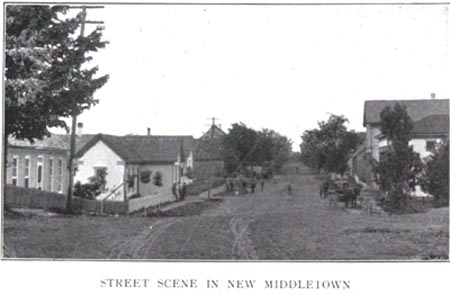
STREET SCENE IN NEW MIDDLETOWN
one just adjoining, now occupied by Clarence
Jordan, was the residence of Daniel C. Lane,
who became Treasurer of State after Indiana was admitted
into the Union.
In the street just in front of his house stands the
pride of the town, the old Constitutional Elm.
This noble tree is sixteen feet in circumference, is
fifty feet high and measures one hundred and twenty-four
feet across its boughs. Its shade in summer
extends across the wide street. A large spring
rises not far from its roots. The cool water from
this spring and the shade of the friendly tree drew our
law making forefathers from the little house behind, and
under the old elm's sheltering boughs in the sunny month
of June, 1816, they framed the Constitution under which
Indiana has grown into a great state.
In the early history of the town no name shines out
with more lustre as a citizen, statesman and patriot
than that of Dennis Pennington. One would
almost think him the guardian genius of the place - a
sort of tutelar saint. He was the oldest of three
brothers who were all identified with the events of that
period. Walter Pennington, or "Uncle
Watty" as he was always called, lived in a house
situated near where the College now stands. He has
a firmer hold on the affections of the people than even
his more educated elder brother. Uncle Watty
could neither read nor write but was a preacher of great
spirit and power. He knew the Bible well, as it
had been read to him by his wife or daughter and was
never at a loss for a text or illustrations. He
was possessed of a most jovial disposition and was much
given to visiting around.
In those days fireplaces were made large enough to burn
cordwood, and friends sat around the cheerful blaze
until far in the night while roasting apples sputtered
on the hearth, and nuts and cider filled up the pauses
in the conversation. Uncle Watty, like all
the Penningtons, was exceedingly fleshy and on
one such night his weight proved too much for even the
substantial splint-bottomed chair on which he sat; it
broke down and was taken to the garret the next day in a
disabled condition, and there the writer of this article
saw it for many a day thereafter.
In 1808 Richard M. Heth built a log house on the
corner of Poplar and Water Streets. This house was
burned down in 1852 while occupied by Mr. Andrew
Broaddus and the present house now owned by John
Morris ad formerly owned by Henry Dannenfelser
was erected in the same place. In this year also,
Jacob Conrad built the stone house on the Corydon
pike known as the Government Hotel. This, however,
is somewhat of a misnomer as Corydon was famous for its
hotels during the
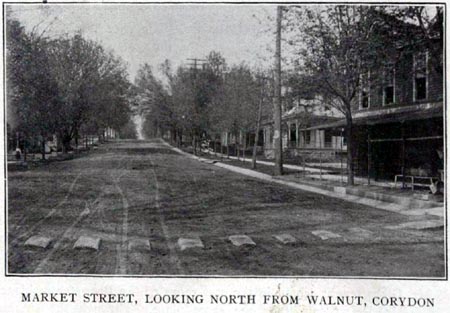
MARKET STREET, LOOKING NORTH FROM WALNUT, CORYDON
time it was the seat of government and it was not
necessary for the members of the legislature to go so
far to board. These law makers came to town on
horseback and the Conrad place had ample
pasturage and stable room, and the horses were kept
there. It became a great place of resort,
especially on Sundays, when games and pastimes were
engaged in. Mr. Conrad, according to the
custom of the times, kept whiskey for his patrons and in
order to have the best article of this kind often sent
his sons as far as Bardstown, Kentucky, for his
supplies.
The town and county gradually filled up with
substantial citizens and in 1809 a great and worthy
ambition seized them. The Commissioners bought of
Harvey Heth and W. H. Harrison an acre and
four perches
|
of ground for a Public Square which at that time
included the lots immediately west of the present square
and extending to Oak Street. Spier Spencer,
sheriff, was ordered to let to the lowest bidder the
contract for clearing off the Public Square and for
building a Stray Pen on the west side thereof with a
fence seven rails high, stake and ridered and a good
ground chunk. This contract was let April
twenty-fifth, 1810, to Henry Berghn for $33.75.
COUNTY OFFICE BUILDING
The first steps taken toward
building the Court House were made on the ninth day of
March, 1809, by the County Judges,
Patrick Shields, Moses Boone and John George
Pfrimmer. The house was built in 1811-12.
The contract was given to Dennis Pennington, but
his brother, Watty, and others built the stone
walls. The shingles were put on by Patrick
Flanigan. The building is of limestone and is
forty feet square. On the roof was placed an iron
balance or scales as emblematic of justice. The
steps to the upper story originally ran up on the inside
and the upper rooms were used as Senate Chamber and
Committee rooms. The floor was made of stone
flagging as far s the bar where it was changed into a
platform of hewn timber. Two very large fire
places, one on the north of the room and one on the
south, heated the house imperfectly. the room was
always damp and the attorneys would emerge from a
prolonged term of court with very bad colds, frequently
terminating in a spell of ague.
In 1833 Mr. Thomas Farquar tore away the old
roof with its emblem of justice and put on a new one.
He hung a bell which has ever since summoned the
citizens to court, to church, to political meetings, to
fires and even to war, for long years after, it rang out
boldly when General John Morgan and his
"gorillas" threatened the life of the little town.
In 1873 the court house was again changed. The
steps were moved to the outside and a board floor took
the place of the stone one and stoves were substituted
for the fire places. It was re-plastered and
re-roofed.
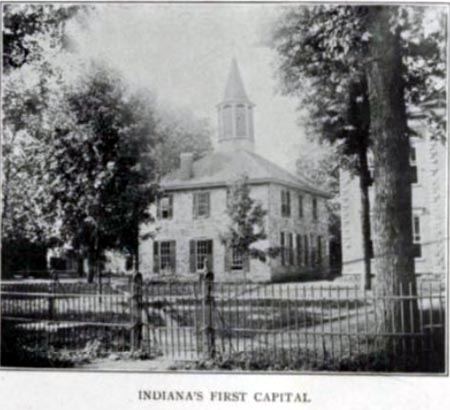
INDIANA'S FIRST CAPITAL
GOVERNOR'S MANSION
The brick building known as
the Governor's Mansion, though it was tenanted by only
one Governor, Jonathan Jennings, was built by
Harbin H. Moore, a lawyer of note, who afterwards,
in 1828, ran for Governor against James Brown Ray
but was defeated. The stairway and mantle shelves
of this house were of hard wood and were handsomely
carved. Governor Posey was in poor health
and would not live in Corydon, and Governor Hendricks
lived in Madison where he owned property, coming to
Corydon at frequent intervals but not to reside.
He roomed at the Porter homestead now
occupied by Patrick Griffin.
A few years to the east of
this mansion stood a two story stone house built by
Reuben W. Nelson, also a famous lawyer. In
this house, on the third day of December, 1817,
delegates from the various State Lodge for the State of
Indiana. Eleven Masons were present at this
meeting; General W. Johnson, S. C. Stevens, Abel C.
Pepper, Christopher Harrison, Henry P. Thornton, Joseph
Bartholomew, John Miller, Davis Floyd, Hezekiah B. Hull,
James Dill and A. Buckner. After
transacting some little business they adjourned to meet
at Madison on the twelfth of January, 1818, and there
the Grand Lodge was duly organized.
In 1822 this house and the Governor's Mansion came into
the possession of Dr. David Mitchell who came
from Pennsylvania. He was the father of John
Mitchell, now living here and who has furnished many
valuable notes for this history. Dr. Mitchell's
first wife was a sister of Governor Jennings, and
their only child and daughter, Anna Maria, was
one of the most accomplished women of the day, adding
Greek and Latin to her other branches of learning.
She afterwards became Mrs. McPheeters.
In 1817 Milo Davis
and Judge Davis Floyd burned a brick kiln in Big
Indian Creek bottom where William B. Slemons'
cornfield now stands. The remains of this kiln
obstruct the plow to this day. A boy who "rode the
horse that tramped the clay" for this brick yard is now
living in Elizabeth at the age of ninety-eight.
His name is David Deatrick.
These men built the house
owned by Judge Porter during his life time, and
the house on the hill above it, now occupied by A. W.
Brewster. the money for all this was furnished
them by Fetter and Hughes of Louisville.
they were unable to pay out and James Hughes, the
surviving partner of Fetter and Hughes,
foreclosed the mortgage and gained possession of the two
houses. From him Judge Porter bought his
house,
|
|
Pg. 53 - Industrial Review,
Biographies and Portraits of Leading Citizens. |
|
which in the meantime had been used for various
purposes, school, stable, sheep shelter and lodging
house. The water from the hill after a big rain
poured down through the hall like a river.
Thomas Crosier was employed by Judge Porter
to build the stone walls around it for the protection
from the water.
BREWSTER HOUSE
The Brewster house
was used for state offices. The room on the east
of the hall was the office of the Auditor of State.
The room on the west side was the Treasurer's office.
A one-story building running at right angles west of it
was occupied by the family and when state balls were
given this house was cleared of its contents and opened
for the festivities. The cellar underneath the
west room was used as a vault for keeping money - but
this was before Indiana had shaken out her ample skirts,
full to overflowing with corn and wheat, or bared her
bosom radiant with "black diamonds" and the gleam from a
thousand gas wells; her revenues now would probably
require large and more secure vaults.
When the capital was moved to Indianapolis in 1825
Samuel Merrill, Treasurer of State, was living in
this house. He was a native of Vermont, was
educated at Dartmouth College and came to Indiana in
1816 after reading law with Thad. Stevens.
He was Treasurer of State from 1823 to 1835 and was
President of the State Bank of Indiana from its
establishment for a great many years. He was also
the first president of the Madison and Indianapolis
railroad which was the first railroad in Indiana.
When he lived at Corydon his family consisted of his
wife and three daughters, Jane, born in Corydon
in 1819, is living now in Indianapolis, a widow, and
mother of William A. Ketcham, former Attorney
General of Indiana; Priscilla was born in 1822,
was married to Alexander Wilson, a Lafayette
banker, and died many years ago. Catherine
Merrill, the well known authoress and teacher of
Indianapolis, was born in Cory-
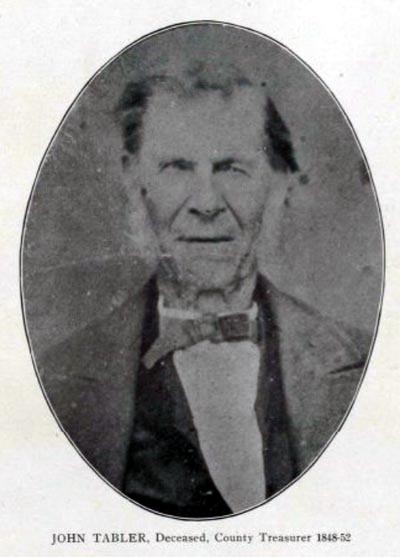
JOHN TABLER,
Deceased County Treasurer 1848-52
don January twenty-fourth, 1824, and died May
thirtieth, 1900, in Indianapolis. She was the baby
when the family moved from Corydon at the time the seat
of government was changed. The household belongins,
state papers, etc., were taken away in two wagons with
the family cow tied behind the last one. Adam
Siebert, who lived in a house near Mauck's
Mill, then owned by Fabrique and Siebert, drove
the team. He had bells on his horses and the
little cavalcade made much sensation when it entered
Indianapolis. Another daughter of Samuel
Merrill, born after it entered Indianapolis.
Another daughter of Samuel Merrill, born after
the removal, is still living in Indianapolis and is the
mother of the Honorable Merrill Moores.
Corydon was incorporated in 1816 but the
organization did not continue. It was incorporated
again January twenty-fourth, 1835, with John Smith,
trustee of First Ward; W. A. Porter, Second;
Lewis Jordan, Third; Thomas Craig, Fourth;
Benjamin Aydelotte, Fifth. There were
twenty-seven votes cast. Corydon lapsed again
and lost her charter but
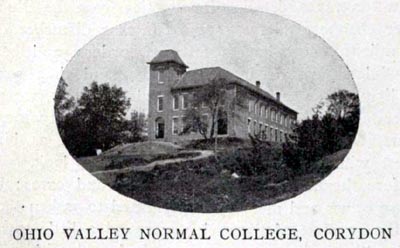
OHIO VALLEY NORMAL COLLEGE, CORYDON.
was re-incorporated in 1849. The board of
officers at that times was James G. May, T. C.
Slaughter, S. K. Wolfe, Thomas Posey and Benjamin
Aydelotte. The removal of the capital in 1825
was a staggering blow to the little town and her sturdy
citizens had much ado to keep her from annihilation.
The brick house now occupied by Edward O'Conner.
Treasurer, was the old home of Henry W. Heth,
Clerk of the County for thirty-eight years. There
seems to have been a squandering of the public funds.
|
even at that early time. Mr.
Heth was accused of giving away too many English
quills to the school children. They were much
better than the ordinary quills in use for pens.
Israel Butt was the first blacksmith to have a
shop in Corydon. He lived in a two story log house
where W. B. Slemons now lives. In this
house Dr. J. D. Irvin and Matilda Thompson were
married over sixty years ago. Dr. Irvin
came to Mauckport as a child in 1826 and was taken by
his father to a Sunday School taught by Henry W.
Fabrique. A great flood in the Ohio river
washed away Mr. Fabrique's property and he came
to Corydon and established the mill afterwards known as
Mauck's Mill. Dr. Irvin reports his
childhood's Sunday School as a model one in every
respect.
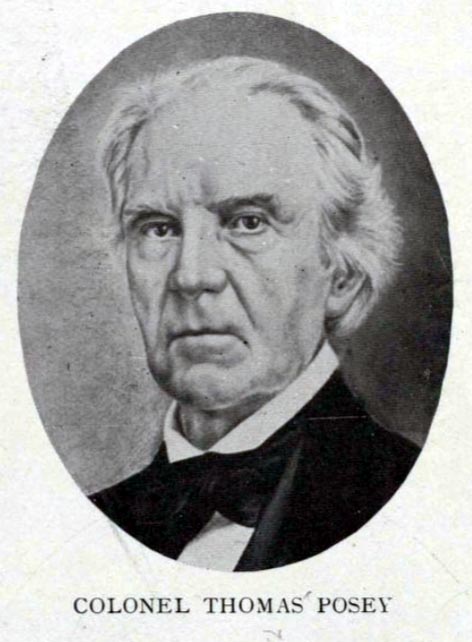
COLONEL THOMAS POSEY
Colonel
Thomas Posey came to Corydon in the early twilight
of the Territorial government. A deep mystery
shrouded his life, the secret of which was known to but
few of the older citizens. He came from Virginia
but brought goods with him from Philadelphia and kept a
store. He owned and lived in the brick house now
occupied by the family of J. T. Wilson. He
also owned a large farm and was independent of
work although he painted wagons and did various other
things. By careless historians he has been
confounded with Governor Thomas Posey who died in
1818 in Shawneetown, Illinois, soon after his term of
office expired, at the age of sixty-four. In 1871
the Cincinnati Commercial printed a three column of the
life of Thomas Posey, but as usual got the two
mixed and the story did not take root. What this
correspondent wrote was not true of Governor Posey,
but it was true of Colonel Thomas Posey who lived
out his pathetic secluded life here in Corydon. He
was the natural son of General George Washington.
He was a most exemplary man and one of the town's most
useful citizens. He was never married. After
the death of his ancient housekeeper, "Aunt Hetty"
Bartholomew, in 1861, he went to Henderson,
Kentucky, to live with a niece and died there soon
afterwards.
Joshua William, grandfather of the Present
Joshua and James Wilson kept the next store.
Abijah Bayless was a partner and they were
located on the southeast corner of Market and Walnut
Streets. This house was originally built by Dr.
Slaughter for a medical office. In those days
the stores were closed before dark.
Peter and Jacob Kintner came to Corydon in 1819.
Jacob Kintner lived at "The Glade", now the
residence of Harry McGrain, and operated a tan
year. His sons were Jacob L., late owner of
Cedar Farm, and Peter S., who died in Paris,
France. Peter Kintner lived in the old
stone house down on Chestnut Street. His sons were
Jacob W., the famous hotel keeper, and Peter
M. Kintner. The original Kintner
brothers entered very much land in and around town.
David Byrn commenced the silversmith business in
1818.
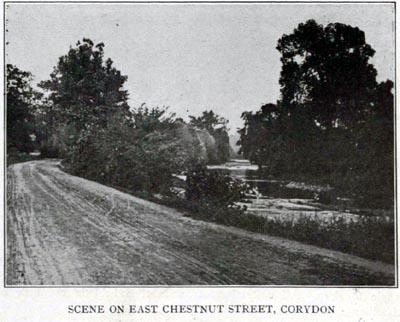
SCENE ON EAST CHESTNUT STREET, CORYDON
James
Giles came in 1816, walking all the way from
Vincennes. He bought out Johnson's hatter
shop and in connection with John Meffert
continued this business for ten years.
Dr. James B. Slaughter came to Corydon in 1813.
He had passed through in 1812 on a military expedition
against the Indians.
Henry Coburn, first clerk of the Supreme Court
of Indiana, had his office in a little house near where
Judge Cook has his office.
The tavern business seems to have been a profitable one
in Territorial times. James T. Jamison came
to Corydon in 1815, married Miss Sarah Lahue and
kept a boarding house down on Chestnut Street.
This he maintained until his death and his widow
afterwards until her death in 1880. David Craig
came in 1816. He was Justice of Peace and kept
|
tavern where the bank of Corydon now stands. When
President Monroe accompanied by General
Jackson, visited Corydon in 1819, they stopped at
Craigs.
PRESIDENT MONROE IN
CORYDON
As
conclusive evidence that President Monroe and his
party were in Corydon we herewith quote from a letter
written by General John Tipton to Samuel
Connor on June 29, 1819. This letter is still
preserved by A. R. Connor of this place.
"On the twenty second instant the President of the
United States, General Jackson and their suite,
dined in this town and left here on the twenty-third at
five in the morning. They staid in Louisville the
twenty-fourth and twenty-fifth, dined in Jeffersonville
on the twenty-sixth and are gone on to Frankfort, thence
to Cincinnati. Their manners were easy and
familiar with every person and their equipage quite
plain. I spent three days with them."
Thomas Farquar, the first squire in town, also
kept boarders, using for them the lower rooms of his
house while his corn and grain were stored upstairs.
Spier Spencer kept hotel until his campaign and
death at Tippecanoe. While Mrs. Spencer was
in the same hotel in 1843 Captain Sanderson with
his company "The Spencer Grays" came from New
Albany to visit her as a mark of respect for the memory
of Captain Spencer with whom they had fought at
Tippecanoe. General Harrison always staid
with the Spencers as did also the famous
Ratliff Boon.
The means of accommodation were not adequate to supply
the wants of the crowds during sessions of the
Legislature. The most important supplies came from
Louisville, but the state of the roads and streams made
their delivery very irregular. When anything was
wanting the wagon from Louisville was anxiously looked
for. This explanation was so often given that to
"wait for the wagon" became a proverbial joke.
The old two-story brick house on Chestnut Street, near
Bulleit's stores was also used as a tavern.
It was built in 1809 by Henry Rice, father of
John, Jacob and Daniel and four daughters.
In the spring of 1807 they left Washington,
Pennsylvania, and came down the Ohio river in flat
boats, stopping first at Tobacco Landing. He
settled on a farm six miles east of Corydon.
Indians were quite numerous, but peaceful.
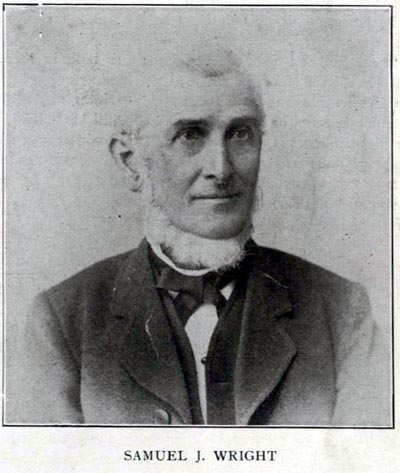
SAMUEL J. WRIGHT
Two years later he came to Corydon
and built what was considered a large and comfortable
house at that time. His son John, born
in1804, was long identified with the history of the
town. He lived here until 1860. In 1845 he
built a grist and saw mill where the "White Mill" now
stands. This was burned down in 1859.
Elizabeth Rice, married Rev. Alexander Williamson,
a pioneer Presbyterian minister.
To return to our hotels. Judan Vigus came
to Corydon in 1816, was a tailor and kept tavern.
He built the corner house where the Morris House
now stands. Afterwads he kept tavern on the
opposite corner, now Shaffer's restaurant.
Samuel Legget had kept this house before him.
Cyrus Vigus then took charge of the same house
and was succeeded by Henry Kinzer, and he by
Jacob W. Kintner. Mr. Kintner, after several
years, opened up the Kintner House on the corner now
occupied by W. H. Keller's department store.
This stood until after the war, and became quite a
historic building. The whole side of the square
was burn in 1871 and Mr. Kintner then erected the
present building on the corner of Market and Chestnut
Streets.
Armstrong Brandon lived in a log house known as
the old Rowland house, now moved back from the
street near the Democrat office. He kept store and
perhaps had a bank, as the Indiana State Bank of
Vincennes had a branch bank in Corydon in 1821. He
was in good circumstances and was quite a
public-spirited citizens. His daughter, Harriet,
is spoken of as the most cultured woman of that time,
with, perhaps, one exception, mentioned before.
Colonel Samuel Judah, a famous lawyer, practiced law
here and in the meantime won a wife. He married
Harriet Brandon and they moved to Vincennes.
Colonel Judah was associated with Henry
Clay in the well-known Myra Clark case, to
recover property in New Orleans.
John Aydelotte kept store in 1820 where Watson's
drug store now stands.
Dr. Benjamin Adams came in 1815. He and
his wife were both victims of the cholera in 1833.
They left an interesting family of children.
John Pitman came prior to 1810.
John Seig came in 1820.
Carter Likens came from Virginia in 1819.
He was at first a clerk in Robert Vance's store,
but afterwards opened up a store of
|
|
Pg. 54 - Industrial Review,
Biographies and Portraits of Leading Citizens. |
his own on the corner now occupied by S. M. Miller's
grocery store. He married Mrs. Heth, a
widow much older than himself and the mother of
Captain Wilford Heth and William Heth, who
was killed at the timer of the Morgan Raid.
Mr. Likens was the soul of honor and a most
useful citizen during a long lifetime. A story of
his later years shows his kindness of heart. The
Fugitive Slave law was then casting its dark shadow over
the land. Many a dusky son of slavery escaped from
Kentucky, crossed the river to Morvin, the first station
in the underground railway, came on to William
Crawford's at "The Sinks," a few miles below John
Rhodes, and then urged his trembling limbs to
Corydon, where there were ten who would return him to
his master to one who would help him on to freedom.
At one time Mr. Likens
had given shelter to a fugitive. The owner came to
town, had Mr. Likens arrested and taken before a
magistrate. He was found guilty and sentenced to
jail. A half dozen friends came forward and
offered to go on his bond, but honest old Carter
had suddenly grown very wicked - he insited on
being taken to jail lest he should forfeit his bond and
get his friends into trouble. In vain the slave
owner urged him to give bail - he was firm and they left
town without any satisfaction. The truth (which
they probably suspected) was that a party of men headed
by Peter M. Kintner were gathered in a blacksmith
shop up on Chestnut Street preparing implements to
batter down the jail in case Mr. Likens should be
put behind the bars.
Benjamin Aydelotte came very early in 1817 and
entered large tracts of land. He had the rank of
major. His regiment was never sent out and he came
west. He kept store many years on the corner now
occupied by R. L. Miller's grocery store, and the
old iron post that was used by him to break iron over
still stands on the corner.
In 1825 the county built a small brick building within
the public square. The Masons were permitted to
build a second story to it and moved their lodge room
there from the old stone house near the Governor's
mansion.COUNTY OFFICE BUILDING
In 1840 a large two-story
brick building was erected by the county for the use of
the officers. This became delapidated and
too small for the purpose, and the county had it torn
down and the present building erected in its place.
This was finished in 1882 and has ever since been
occupied.
A handsome jail and Sheriff's residence was built in
1873.
In 1829 Dr. David G. Mitchell was publishing a
paper here called The Public Press. He had in his
employ a printer named Ladd. For some
reason not known this man attempted to kill his wife.
He stabbed her twice and then cut this own throat.
Mrs. Ladd was not killed and veracious
history affirms that the heavily-corded corset she wore
saved her life. Ladd was buried in an
obscure corner of the cemetery and his grave was shunned
until lost sight of. It cannot now be located.
This was the first suicide in the town or county.
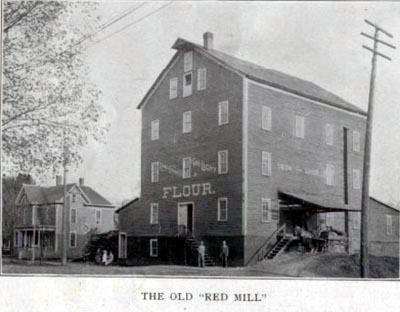
THE OLD "RED MILL"
The Red Mill was built by a
stock company in 1833. It has had various owners,
prominent among whom was Robert Leffler, also an
early resident of the town. A little romance
attaches to his history, which may not be out of place
to mention now. In his early manhood he was deeply
attached to a young lady mentioned in another place in
this history and this feeling was said to have returned.
When she, in deference to her father's wishes, married
another, Mr. Leffler remained true to her, and
though fond of society and a great favorite in social
circles, he never married. this Mill has been
repaired and improved by its present owner, E. L.
Pitman, and still helps supply the town and county
with the staff of life.
Arthur Vance owned the brick building on the
Northwest corner of Chestnut and Market Streets and kept
store in the corner room for many years. He died
just before the great Morgan raid at a ripe old age, and
was buried in the evening before that memorable day.
Scarcely enough men could be gathered together to give
him decent burial.
His brother Robert, also an ancient and
honorable citizen, kept store on the corner of Market
and Commercial Row. No better men ever lived in
Corydon.
In 1840 Dr. A. M. Jones and George Robinson
were publishing The Corydon Whig. It was the year
of the log cabin and hard cider campaign. As in
duty bound, the town went wild over Harrison's
election, and the next night the windows were
brilliantly illuminated with tallow candles and a noisy
procession paraded the streets. the next morning
was a time for tears among the housewives, for the
dripping grease from the candles had ruined many a rag
carpet.
|
Again in
1856, during the Know Nothing excitement, the town
roused itself and had a torchlight procession.
Before dispersing, the crowd assembled in front of the
office of The Corydon Whig, which had been edited for
two years by Ignatius Mattingly, and then and
there burnt him in effigy because he refused to advocate
Know Nothing principles.
Harrison County has ever been a hotly contested
political battlefield, and Corydon has had many a
notable assembly within her borders. Besides four
Presidents of the State has harangued our people.
The finest orators of national reputation have been
detailed to teach our citizens how to vote.
Eminent men from everywhere over the country have eyed
the hoary stone building in the Public Square and asked,
"When was this old house built? to have answer from the
proud and happy citizen: "In 1811, by Dennis
Pennington."
HARRISON COUNTY'S ILLUSTRIOUS SONS
Corydon and Harrison County can lay claim to a long line
of illustrious sons. Besides General Tipton
and Captain Spencer, there might be mentioned
Allen D. Thom, Adjutant General of Indiana;
Daniel C. Lane, Davis Floyd, Dennis Pennington, Walter
Q. Gresham, General Sparks, Land Commissioner during
Cleveland's first term; Robert Tracewell,
Controller of the Treasury; W. T. Jones,
Congressman from Wyoming Territory; Ex-Congressman S.
M. Stockslager, Land Commissioner
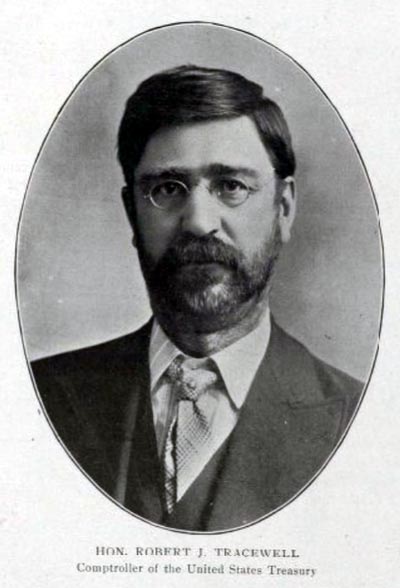
HON. ROBERT J. TRACEWELL
Comptroller of the United States Treasury
under Cleveland; Josiah
Lincoln, uncle of Abraham Lincoln;
Ex-Congressman Simeon K. Wolfe, Congressman W. T. Zenor,
T. C. Slaughter, Assessor of Internal Revenue and
Indian Agent; Harbin H. Moore, Reuben W. Nelson,
William A. Porter, Colonel G. W. Friedley, James H.
Jordan, Chief Justice Supreme Court of Indiana;
General James C. Veach, and George W. Self,
Reporter Supreme Court.
Mary E. Nealey's early home was here, and as "Mary
Neal" her poems were widely published.
Likewise Brainard Williamson, also a poet of
high standing, who has for fifty years edited a paper in
Philadelphia, and Dr. E. S. Crosier, who had high
literary attainments and was without a peer as a
scientist and antiquarian.
Miss Abbie Slemons, sister of Dr. Slemons,
wrote poems of much merit, many of which were published
in the Cincinnati Gazette. Especially fine were
those written during the war on patriotic themes.
She died in Corydon September third, 1863.
Dr. John Slemons and Dr. Sloan, a famous
surgeon, came from the East as young men in 1833.
Dr. Sloan located in New Albany and Dr.
Slemons came here. He had a hard struggle
before he gained a foothold, but when he died was
reckoned among the wealthiest men of the town.
After the opening of the plank road in 1851 Corydon
improved and increased in size, and this history will
not be able longer to specify just who lived on every
corner. An outlet was made to the world and the
world looked in on the happy valley.
Mesmerism was first attracting attention in the East,
and a stray lecturer came to Corydon and gave specimens
of his skill in putting people to sleep. All
entertainments were then held in the little old
schoolhouse, which was burned down in 1872.
The Fox Sisters had startled the world with the
revelations of Spiritualism, and in good time Corydon
was visited by a medium, and strange "rappings" were
heard and chairs and tables "danced" as merrily here as
anywhere else.
S. F. Simpson, a celebrated Daguerrean Artist,
came to town and all who wished an "Imperishable shadow"
of themselves could find him at Kintner Hotel.
The Harrison County Lyceum, organized November
eleventh, 1851, met every week in the Seminary. A
lecture was given by some local celebrity and great
questions were discussed. One evening this
question was up for discussion: "If Cuba Should
Attempt to Rise Against a Foreign Power, ought the
United States to interfere?" It took fifty years
or more to find a solution to that problem.
|
THE FIRST PIANO
Years passed
and Corydon grew slowly. In 1851 the Misses
Harris opened a young ladies' boarding school.
They brought the first piano. The writer of this
article, a girl of nine years, was permitted to go with
an older sister, ho took lessons, down to see the
wonderful instrument and listen to the inspiring strains
of "Bonaparte Crossing the Rhine." A few years
afterwards the famous Rissinger Brass Band of New Albany
was engaged to furnish music for an immense political
meeting held in a grove above the Blue Spring, at which
both Oliver P. Morton and A. P. Willard
were present as joint speakers.
The music of this band set the town wild. T.
D. Nutting, a musician of New Albany and leader of
the Band that day, was persuaded to come down on the
stage once a week and teach music here. He
organized a Brass Band, and an Orchestra and had
numerous piano pupils, besides a large singing class.
C. M. Miller, whose father was leader of the
Orchestra, has furnished the names of the members of
these two bands. They are as follows:
Corydon Saxhorn Band, organized 1855.
|
Alanson Pollard,
Leader. |
Thomas
Redfield
H. M. Applegate.
Robert Leffler.
James D. Irvin.
R. H. Heth |
John T. Heth
John G. Mitchell.
William W. Bean.
Thomas Farquar.
Elijah Hurst. |
Orchestra
|
James M. Miller,
Leader |
Hugh Neely.
Thomas C. Slaughter.
E. J. McBride.
Henry M. Heth. |
Philo G.
Leslie.
Leslie Boone.
Henry Jordan.
J. T. Wilson |
In the
course of time J. T. Wilson took charge of these
bands, and for many years furnished music for all
occasions. After him William Sims became leader.
At his death, Milton Miller was chosen leader.
Under its last leader, James Brewster, it has
kept up its popularity at home and abroad - has played
in New Albany and held its own with city bands at Two
Confederate reunions in Louisville and at the meeting of
National Lodges of Knights Templar in the same city.
The Sons of Temperance was organized in New York City
in 1842. On the fifteenth of November, 1845, the
first division was organized in this state at Brookville
under the title of Indiana Division Number One.
the Harrison County Temperance Society held its first
meeting March eighteenth, 1851, and had its hall over
J. M. Bean's store, corner of Chestnut and Elm
Streets.
After the Branch Railroad was built a great change was
apparent in the town, and since then her growth and
improvement have been steady. The classic banks of
Big Indian are lined with shops and factories. A
wagon and a hub factory give employment to many hands.
There is a cannery, a creamery and a cold storage plant.
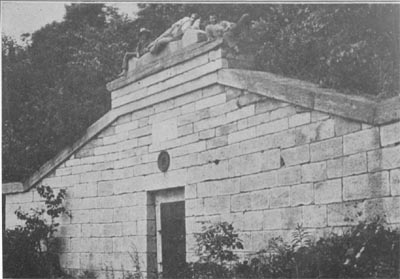
McHARRY'S TOMB
The
telephone sent is first whispered message here about
fifteen years ago - now the Cumberland and Eureka lines
enable us to talk to far distant friends. In 1894
W. H. Keller established an Electric plant, by
which buildings and stores were lighted - this was
extended to the streets in 1896. In 1894 he built
waterworks for supplying the town with water. In
1903 the town board took up the matter and laid a system
of water works, drawing its supplies from the Blue
Spring.
A greater change awaits us soon, for that disturber of
the peace, the electric railroad, now hovers on our
borders, and before another year will doubtless
penetrate into our midst, and then sentiment must give
way to living the strenuous life. In view of this,
we give Corydon this fond farewell - Sweet Corydon!
mother of mighty men. Thy sons and daughters, when
they turn from thee, go out as birds from an outgrown
nest with many a lingering, backward look. Wider
scenes open out before them, bringing mingled joys and
cares; but when an hour of leisure comes and memory is
permitted to waken thoughts of by-gone years, the
sweetest of these cluster round a little town shut in by
hills, girdled with rippling streams, overshadowed with
peace and fragrant with the happy dreams of youth.
McHARRY' TOMB
On a high bluff just
below Bridgeport, on the Ohio river, is a piece of
masonry known as McHarry's Tomb. Captain
Frank McHarry whose home was in Portland, Kentucky,
was, before the war, a steamboat captain and owner of
immense tracts of land on the Indiana side about |
|
Pg. 55 - Industrial Review, Biographies
and Portraits of Leading Citizens. |
Bridgeport,
and one of the ferry boats plying between Louisville and
New Albany bore his name. He had the contract for
building the first canal about the Falls. He was
an eccentric character and built for himself his tomb on
the river hill in order, as he said, "that he might
curse the steamboat captains as they passed below."
His body rested there for many years, but has recently
been removed by his family and buried in Cave Hill
Cemetery, in Louisville.LANESVILLE
Edward Pennington
made oath to the original plat of Lanesville December
eleventh, 1817. There was, however, a settlement
there years before this time. The Penningtons
came in 1792, and after them followed the Gwinns,
Harbisons and other pioneers. James
Armstrong settled just below Lanesville, where, in
the creek bottom, there is an old salt spring, from
which salt was distilled a hundred a hundred years ago.
Lanesville was surveyed by the government Surveyor,
Mr. Lane, for whom the town was named A later
addition was laid off by Robert Biggs August
eleventh, 1855. A company of the Second Indiana
Volunteers. |
NEW SALISBURY
The plat of
this town was filed August twenty-eighth, 1830, by
John Kepley, and named after his old home,
Salisbury, North Carolina. The record says that
he, as proprietor, agrees to give as a donation to
inhabitants of said town the liberty of all springs of
water lying southwest and southeast of the south end of
Main Street and, farther, he binds himself to give a
sufficient quantity of ground west of the spring branch
for a meeting house and schoolhouse.
MORVIN
Harvey Heth
filed the original plat of Morvin September
seventh, 1816. This was the first station on the
underground railroad in Indiana. It was the farm
of David Bell, who was imprisoned just before the
war, accused of assisting slaves to escape from
Kentucky. The last house in the village was shot
through by a cannon by Morgan's men before
crossing the Ohio river July eighth, 1863. It was
then occupied by Newton McCarty. |
TOBACCO LANDING
Although not
a town, this place does more in the way of shipping than
any other point in the county. It was the boyhood
home of J. Ross Browne, whose vivacious books of
travel delighted the readers of his day and were
considered almost the equal of tose written by Bayard
Taylor. This place got is name thus: In
the early days of this county a large flat boat-load of
tobacco was passing down the Ohio river.
When it reached a point near where Tobacco Landing now
is, this boat sprang a leak, and by the time it could be
rowed to the Indiana shore it was leaking so fast that
the boat soon sank in shallow water. The owners
unloaded all the tobacco, spread it out on the banks and
let it remain several days until it was thoroughly dry.
They then repaired the boat, reloaded the tobacco and
proceeded South. Since then that place has been
called Tobacco Landing.
BEUNA VISTA
The
land for the town of Buena Vista was given by William
Wallace in 1850, but it has not filled his
expectations, and is now not much more than a
postoffice. It was here that an aerolite fell in
1859, creating much excitement. A glare of light
was seen and loud bursting reports were heard about four
o'clock on the afternoon of March twenty-eighth.
These were followed by hissing sounds in the air for
miles around and a rattling noise as the fragments fell
in different places. Dr. E. S. Crosier, a
well-own scientist, went immediately to the scene and
secured pieces for examination. the aerolite was
afterwards sent by him to the British Museum in London.
BRADFORD
Ulrich H.
Hon plated and laid out the town of Bradford July
twenty, 1838. Although an old town, it has not had
a very eventful history. The Indian trail across
the upper part of the county passes near the town.
General Harrison stopped for a night at a wayside
inn then standing two miles east of Bradford on this
trail. He was carrying money to Vincennes and was
accompanied by a guide.
NEW MIDDLETOWN
Henry
Sechrist gave the land and laid out the town of New
Middletown October sixteenth, 1860. Jacob
Himmelheber carried the chain when it was surveyed
by James Armstrong, who did almost all the
surveying in the county while he lived. This town
is in the midst of rich and well-kept farms and the
people are prosperous and energetic.
MOBERLY
Moberly is a settlement and postoffice in Spencer
township. The residence and farm of John S.
Burgess is here. He has one of the finest
peach orchards in the State, and the Burgess
peach is a synonym for the best there is in that line.
WINNSBORO
An ancient
town laid out by John R. Wynn April twenty-fifth,
1820.
HURSTOWN
Hurstown was
settled by John Hurst, who came from Culpepper,
Virginia, and landed at this point about 1800 with
several of his children and their families. |
|
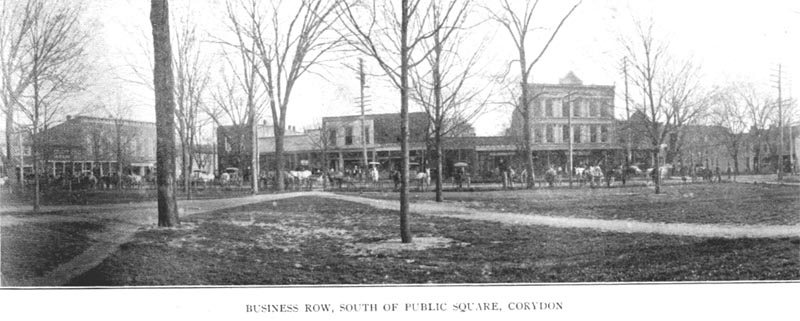
BUSINESS ROW, SOUTH OF PUBLIC SQUARE, CORYDON.
|
|
for the Mexican War was largely recruited around
Lanesville, as was also the "Yellow Jackets," Captain
Spencer's company in the Indian War under General
Harrison. Lanesville was first settled by
Americans, but is now almost entirely German.
ELIZABETH
The original plat of
Elizabeth was sworn to by William D. Little
before John Tipton, Justice of Peace, April
seventeenth, 1812. The town was incorporated March
eighth, 1819, with five trustees, as follows:
Joshua Farnsley, Robert Rusk, Alexander McRae, John W.
Jones and Zachary Stocker. E. Veatch
was president of this meeting and John Zenor,
Clerk. Mr. Veatch, who gave the land, named
the town for his wife. The oldest building in
Elizabeth is the P. H. Flanigan house. built in
1813, and later occupied by R. J. Tracewell's
grandfather. The first church was a Baptist, which
stood in the old cemetery.
MAUCKPORT
The land on which the old
town of Mauckport stands was owned by Frederick Mauck,
who laid out the town. He came to Harrison county
in 1811. the original plat was filed in Recorder's
office May seventh, 1827, having been sworn to before
Samuel Reaugh, Justice of Peace, April seventeenth,
1827. The date of the erection of the old houses
now standing was built into the flues by a mason named
James A. Harper. The earliest settlers came
from Shenandoah Valley, Virginia, and Lancaster County,
Pennsylvania. In 1850 it bore the name of New
Market, but as there was another town and post office by
that name it was changed back to Mauckport.
LACONIA
John Boone,
as one of the proprietors, made oath to the original
plat of Laconia, March ninth, 1816. The oldest
houses now standing were built in 1832, and are owned by
George Byrum and Edward O'Connor.
PALMYRA
Originally
McCallen's cross roads was leased by Hays
McCallen November fourteenth, 1810. The town
was laid out in forty-eight lots and named Carthage in
October, 1836. Afterwards another plat was made,
adding sixty-four more lots of the same size as the
original ones, and the name was changed to Palmyra on
account of postal difficulties, there being another town
named Carthage in the State. this was done March
twenty-fifth, 1839. It is said McCallen got
his land from a squatter who became crowded when
Fredericksburg grew up four miles on one side of him and
Greenville six miles on the other. Jonathan F.
Hancock, one of the oldest settlers, walked from
Hancock's Chapel to Jeffersonville to enter land.
BOSTON
This town, in
Taylor township, now vacated, flourished chiefly about
the time of the Civil war. It had about
sixty-eight inhabitants, three stores, two churches, a
school, a blacksmith shop, a carding machine and about
twenty dwellings. It was started as a woodyard,
where steamboats could stop and get fuel. |
FRENCHTOWN
J. B. Bogard,
LeFever and Theo Henriott were among the
first settlers in Frenchtown in 1840 - in all, about
fifty families from France established a colony there.
The first church was built at the old graveyard in 1847.
The town was first called St. Bernard, after the name of
the church, but was changed to Frenchtown when a
postoffice was established there.
NEW AMSTERDAM
Like all
the river towns, New Amsterdam was platted and laid out
as a town at an early period, September nineteenth,
1815, by Jacob Funk and Samuel McAdams.
Although still a small place, it is a busy one, and a
good point for shipping produce on the river. Two
Revolutionary soldiers are buried on the banks of Indian
creek, one mile below town, named Daniel and Henry
Funk. |
|

BIRDS EYE VIEW OF MAUCKPORT
|
|
BRIDGEPORT
Bridgeport was
laid out as a town in September, 1849, by Thomas
Joyes and David M. Farnsley, who gave the
land. It is in a fertile valley between the river
hills and has its share of shipping by the river.
NORTH HAMPTON
This
town, now scarcely known, was platted and laid out by
James Riley May twenty-fifth, 1815, and surveyed by
David Richardson. An addition was made by
Jacob Youtsler. Its streets, named Queen
Anne, Bell, St. John, etc., etc., smacks of kings and
coronets, and with its own name would indicate the first
settlers to be English. They were shanty boat
families, and the village never amounted to much.
the citizens were noted for want of enterprise and
industry, and excessive gambling, drinking, horse
racing, fighting and a notorious murder. The
demoralization of the town caused is death in fifteen
years. The old North Hampton road to Corydon was
among the earliest roads, but much of it has been
abandoned. |
BYRNVILLE
Temple C.
Bryn emigrated from North Carolina in 1809 and
settled on the site of Brynville, which he platted and
laid out in October, 183.
OTHER THRIVING TOWNS
Valley City -
Land was given by James H. Trotter and Jacob
C. Lopp. This land was deeded to them by
John Trotter. It was surveyed in November,
1859. Recorded January eleventh, 1860
Fairdale - October fifteenth, 1867; John McPheeters.
Crandall - Cornelius F.
Crandall; June eleventh, 1872
Central City (Mott) - George A. Crosby;
May twelfth, 1883.
Depauw - April eighth, 1884; Felician Henriott.
Gresham - North half of
Corydon Junction, named for General W. Q. Gresham.
Land given by S. J. Wright, S. M. Stockslager and
Thomas McGrain, November fourteenth, 1883. |
|
Pg. 56 - Industrial Review, Biographies
and Portraits of Leading Citizens. |
O'Bannon - South half of
Corydon Junction; land given by Joseph Deweese,
September third, 1889.
Jackson City (Ramsey) - H. C. Ramsey, March
fourteenth, 1883.
Central - May thirty-first, 1890; William Smith.
THE FIRST WEDDING.
Major Harbison
settled near Lanesville at about the same time that
Edward Smith settled at the Fair Ground spring.
The Major was a prominent figure on muster days at that
early time. It was in this house that the first
wedding took place. The parties were William
Pennington and Jane English. Dennis Pennington
had previously married her sister.
THE FIRST MARRIAGE LICENSE
Caleb Newman to Patsey
Hancock, February seventh. Were married
February eighth, 1809, by James Long.
SECOND LICENSE
John Dawson to Hepsey
Onion, March eleventh. Were married March
twelfth, 1809, by James Long.
NEWSPAPERS.
The Indiana Gazette,
November, 1818.
The Corydon Press, September, 1829, Dr. D. G.
Mitchell, Editor.
The Corydon Investigator, 1835.
The Corydon Whig, 1840, Dr. A. M. Jones and
George Robertson, Editors.
The Harrison Gazette, 1843, Ignatius Mattingly,
Editor.
The Southern Indianian, 1847.
The Western Argus, March eleventh, 1851, T. C.
Slaughter, Editor
The Corydon Democrat, established 1856, S. K. Wolfe,
Editor, followed by A. W. Brewster, Askren
and Stockslager, G. K. Gwartney and C.
W. Thomas and C. B. Eliss.
The Corydon Argus, 1861, George W. Beard,
Editor.
The Corydon Weekly Union, 1863, Andrew Broaddus,
Editor.
The Farmers' Advocate, W. H. Hudson, Editor.
The Old Capital, Lemmon and Askren,
Editors.
The Comet, C. L. Dick, Editor.
The Corydon Republican, established August, 1868;
Editors, Henry Jordan and W. T. Jones,
afterwards, Self and Adams, then G. W.
Self.
Harrison County Democrat, 1886, D. J. Murr and
C. W. Thomas, Editors
FIRST JUDGES OF COURT OF COMMON PLEAS, MAY 10,
1809
Patrick
Shields
John George Pfrimmer
Moses Boone. |
|
At June term Peter
McIntosh succeeded Pfrimmer as Judge of Court
of Common Pleas and John Hurst succeeded Spier
Spencer as Sheriff.
FIRST JUDGES OF THE CIRCUIT COURT,
NOVEMBER, 1814.
|
Jesse L. Holman, President |
Daniel C.
Lane
Patrick Shields |
} Associates |
APRIL TERM, 1817
|
Honorable David Raymond, President |
Patrick Shields
Peter McIntosh |
} Associates |
NOVEMBER TERM, 1817
|
Honorable Davis Floyd, President |
Patrick
Shields
Peter McIntosh |
} Associates |
APRIL TERM, 1818.
|
Davis Floyd, President |
Peter
McIntosh
Fielding M. Bradford |
} Associates |
APRIL, 1820, SAMUEL LEGGETT, MASER
IN CHANCERY.
SEPTEMBER TERM.
|
Davis Floyd, President |
James
Kirkpatrick
Peter McIntosh |
} Associates |
MARCH TERM, 1823
|
Davis Floyd, President |
James
Kirkpatrick
Abijah Bayless |
} Associates |
JUNE TERM, 1823
|
John F. Ross, President |
| The Same
Associates |
|
MAY TERM, 1824, TO APRIL TERM, 1831
|
John F. Ross, President |
John
Harrison
Moses Boone |
} Associates |
APRIL TERM, 1831.
|
John F. Ross, President |
Craven Lynn
Moses Boone |
} Associates |
|
OCTOBER TERM, 1831.
OCTOBER TERM, 1834.
| John H. Thompson,
President |
|
Fielding Cromwell
Craven Lynn |
}Associates |
| |
|
OCTOBER TERM, 1836.
| John H. Thompson,
President |
|
Fielding Cromwell
John Hogan |
}Associates |
OCTOBER TERM, 1845.
| William P. Otto,
President |
|
Fielding Cromwell
John Hogan |
}Associates |
APRIL TERM, 1852.
| William P. Otto, Sole
Judge |
|
APRIL TERM, 1853.
| George A. Bicknell |
|
| Jackson County Man |
|
| T. C. Slaughter -
died - |
1872 to 1879 |
| George W. Denbo -
appointed - |
1879 |
| Samuel Ramsey - |
1880 to 1886 |
| W. T. Zenor - |
1886 to 1897 |
| R. S. Kirkham -
appointed - |
1897 |
| C. W. Cook - |
1898 to 1910 |
JUDGES OF PROBATE COURT
| W. A. Porter,
November, 1829, to February, 1834 |
| Lyman Leslie to
November, 1834 |
| George Bentley to
November, 1842 |
| Charles D. Murray to
May, 1843 |
| Lemuel S. Leonard to
August, 1847 |
| T. C. Slaughter to
August, 1848 |
| Craven Lynn |
JUDGES OF COURT OF COMMON PLEAS.
| William Mowow,
January, 1853, to November, 1856 |
| Fred W. Matthis to
February, 1861. |
| Amos Lovering to
April, 1864 - resigned. |
| B. P. Douglass to
August, 1864. |
| W. W. Gilliland to
ninth day August term. |
| B. P. Douglass to
December, 1864 |
| Patrick H. Jewett to
December, 1872 |
| Charles P. Ferguson,
December, 1872, one term, when Common Pleas
was abolished. |
HARRISON COUNTY CLERKS
| George F.
Pope |
1809 |
| R. M. Heth |
April 1811 |
| Henry W.
Heth |
1818 to 1852 |
| Hugh Neely |
1852 to 1856 |
| George W.
Denbo |
1856 to 1860 |
| D. M. Jones |
1860 to August
1864 |
| S. W.
Douglas |
August to
November 1864 |
| William
Hancock |
November 1864
to 1868 |
| B. P.
Douglass |
1868 to 1872 |
| John Ridley |
1872 to 1880 |
| William
Ridley |
1880 to 1884 |
| D. F. Lemmon |
1884 to 1888 |
| Alva Smith |
1888 to 1892 |
| Amos Lemmon |
1892 to 1896 |
| Otto
Cunningham |
1896 to 1900 |
| Albert Bline |
1900 to 1904 |
| James McRae |
1904 |
TREASURERS OF HARRISON COUNTY
| Gillis
McBean |
1818 appointed |
| Thomas Posey |
1818 appointed |
| Armstrong
Brandon |
1824 appointed |
| John W.
Payne |
1828 appointed |
| Robert Vance |
|
| John Tabler |
1849 to 1853 |
| George W.
Denbo |
1853 to 1855
elected |
| John Deweese |
1855 to 1857 |
| James W.
Starr |
1857 to 1859 |
| Willison
Hisey |
1859 to 1863 |
| E. H.
Richards |
1863 to 1867 |
| Edward
Harbeson |
1867 to 1871 |
| Lewis W.
Bowling |
1871 to 1875 |
| William
Benson |
1875 to 1879 |
| Lewis W.
Bowling |
1879 to 1883 |
| John C.
Graves |
1883 to 1887 |
| A. T. Funk |
1887 to 1889 |
| Patrick
Griffin |
1889 to 1893 |
| William
Meyer |
1893 to 1895 |
| John W.
Marshall |
1895 to 1897 |
| Levi
Sappenfield |
1897 to 1902 |
| Edward
O'Connor |
1902 to 1906 |
| John M.
Baelz |
1906 to 1908 |
CORONERS OF HARRISON COUNTY
| William Heth |
1834 to 1838 |
| William Booker |
1838 to 1842 |
| William Applegate |
1842 to 1844 |
| Samuel Little |
1844 to 1846 |
| David Groves |
1846 to 1848 |
| Harvey Steepleton |
1848 to 1850 |
|
| Job Robinson |
1850 to 1853 |
| James H.
Richards |
1853 to 1854 |
| William R.
Hunter |
1854 to 1856 |
| Upton Boone |
1856 to 1860 |
| Z. B. Cooper |
1860 to 1862 |
| George
O'Conner |
1862 to 1870 |
| James Wilson |
1870 to 1880 |
| George
Kintner |
1880 to 1884 |
| A. J. Glaze |
1884 to 1894 |
| William
Windell |
1894 to 1896 |
| P. S. Wright |
1896 to 1900 |
| William S.
Nye |
1900 to 1905 |
| P. S. Wright |
1905 |
SURVEYORS OF HARRISON COUNTY
| Adam Crosier |
1854 to 1856 |
| James
Armstrong |
1856 to 1868 |
| John
Brewster |
1868 to 1882 |
| Sam Roberts |
1882 to 1883 |
| Lafe Crosier |
1883 to 1884 |
| Amos Zenor |
1884 to 1887 |
| William B.
Douglass |
1887 |
| L. M.
O'Bannon |
1887 to 1890 |
| A. J.
Armstrong |
1890 to 1892 |
| J. V. Denton |
1892 to 1894 |
| William
Churchill |
1894 to 1896 |
| Joseph E.
Bunch |
1896 to 1898 |
| Thomas J.
Wright |
1898 to 1899 |
| Dan Sharp |
1899 to 1903 |
| Hugh Rhodes |
1903 to 1906 |
| Arvel Snyder |
1906 |
RECORDERS OF HARRISON COUNTY
| H. W. Heth |
1841 |
| L. S.
Leonard |
1855 to 1859 |
| N. B. Boone |
1859 to 1862 |
| Conrad
Hottell |
Sept. 30 to
Oct. 8, 1862, appointed |
| Marion Hise |
1862 to 1866 |
| M. M. Hon |
1866 to 1870 |
| William
Zollman |
1870 to 1874 |
| William B.
Hunter |
1883 till
successor elected |
| Henry Wright
|
appointed |
| John M.
Baelz |
1886 to 1890 |
| L. M.
O'Bannon |
1890 to 1894 |
| Edward S.
Tuell |
1894 to 1898 |
| Henry D.
Denbo |
1898 to 1902.
Hold over |
| Frank M.
Wilson |
January 1, 1903
to 1907 |
AUDITORS OF HARRISON COUNTY
| T. C.
Slaughter |
1842 |
| S. J. Wright |
1847 |
| B. P.
Douglass |
1851 |
| B. P.
Douglass |
1855 |
| S. W.
Douglass |
1859 |
| William
Miller |
1863, Resigned
Dec. 1866, B. P. Douglass appointed. |
| S. J. Wright |
1867 |
| A. W.
Brewster |
1871 to 1875 |
| C. M. Miller |
1875 to 1879 |
| A. W.
Brewster |
1879 to 1883 |
| A. W.
Brewster |
1883 to 1887 |
| James
Woodward |
1887 to 1891 |
| Leslie
Trotter |
appointed to
fill vacancy November 1889 |
| C. W. Cole |
1890 November |
| T. S.
Getzendanner |
1894 |
| James Watson |
1898 Hold over |
| George Hess |
Jan. 1, 1903 to
Apr. 1904 |
| Frank Watson |
appointed 1904 |
| Frank Watson |
January, 1905
to 1909 |
LIST OF HARRISON COUNTY SHERIFFS
| Spier Spencer |
11809 |
| John Hurst |
1812 |
| John Tipton |
1817 |
| Joseph Paddocks |
- |
| Jesse Shields |
- |
| Frederic Leslie |
- |
| Colonel William Gresham |
- |
| Dennis Pennington |
- |
| Jessie Shields |
1834 to 1836 |
| Dennis Pennington |
Aug. 14, 1836 to Aug. 1,
1838 |
| William Madden |
1838 to 1842 |
| James Giles |
1842 to 1846 |
| William Gwinn |
1846 to 1850 |
| William McMahon |
1850 to 1854 |
| James Giles |
1854 to 1856 |
| Jacob Stockslager |
1856 to 1860 |
| John F. Cunningham |
1860 to 1864 |
| Henry Zenor |
1864 to 1868 |
| Peter Endris |
1868 to 1872 |
| Silas Craydon |
1872 to 1876 |
| Lewis Brown |
1876 to 1880 |
| Joseph L. Marsh |
1880 to 1884 |
| S. J. Bence |
1884 to 1888 |
| Claiborne Shuck |
1888 to 1892 |
| Nathan McElfresh |
1892 to 1894 |
| William Blake |
1894 to 1896 |
| J. M. Balz |
1896 to 1900 |
| Philip Lotich |
1900 to 1905 |
| William B. Ludlow |
1905 to 1907 |
|
|
Pg. 57 - Industrial Review, Biographies
and Portraits of Leading Citizens. |
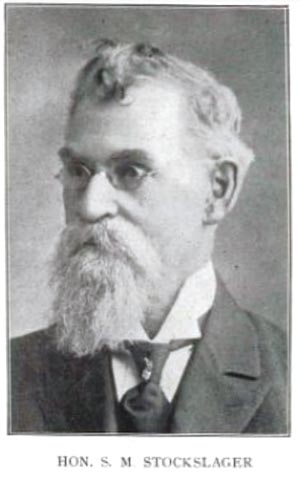 |

SCENE CORNER MARKET AND HIGH STREETS,
CORYDON
|
INDUSTRIAL
REVIEW, BIOGRAPHIES AND
PORTRAITS OF LEADING CITIZENS. |
|
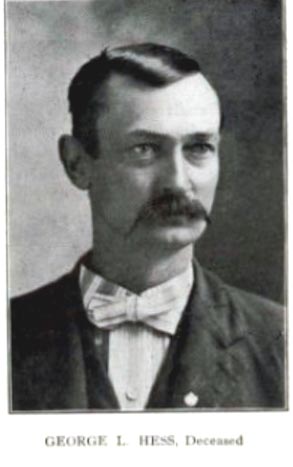 |
|
|
V. H. BULLEIT & SON
In the mercantile business,
Corydon and Harrison County have made wonderful
developments in the past few years, and the various
institutions, which are continually increasing in
number, are enjoying an increase in volume of business
over the preceding yeras. The farming community as
well is keeping pace with the times and, comparatively
speaking, Harrison County products, both in quality and
quantity, are equal to those of any other county of this
state. The farmers are, as a whole, educated,
prosperous and a well-to-do class of people, who keep
fully posted as to how they may obtain the best results
from their respective farms. In order to do this
they fully realize that they must use the very best of
materials and employ the most modern and labor-saving
equipment. With these facts in view, a merchant
wastes his time by attempting to handle any goods that
do not measure up to the standard and give satisfactory
results.
In connection with these remarks we desire to call
attention to a business enterprise that fully complies
with the above demands and one that is putting forth
every effort to meet the requirements of all patrons.
This concern is prominently represented by the extensive
establishment conducted by V. H. Billeit and Son.
There is no business house in Corydon that has
shown a more marked development of late years. It
is one of the largest establishments of its kind in
Southern Indiana and has been in operation in Corydon
for nearly a third of a century, and no establishment is
more generally or better known than is this concern.
Since its incipiency it has had at its head a practical
and well-informed manager, in the person of V. H.
Bulleit, who learned from his youth that honorable
and upright dealings with his fellowmen was the only
means of success. this has been carried out during
his entire business career and to-day he enjoys all the
pleasure that comes from a successful business life.
The original firm, which was organized by Bulleit
Brothers in the year of 1886, has undergone some
changes in the firm name, but the original ideas of its
earliest promoters have been fully carried out in every
respect, and it is to-day a model farmers; supply house
of which Corydon and Harrison County may well be proud.
During all these years department after department has
been added to the business as the demand required, and
we now find this firm occupying two large two-story
buildings, consisting of two rooms each, 25x63 feet and
30x63 feet in dimensions, respectively, besides five
warehouses that are located along the railroad tracks as
a matter of convenience for handling heavy merchandise.
Altogether they occupy upward of 17,000 feet of floor
space, and every room is filled with merchandise that
experience has taught them is the best in their
respective lines.
The line of goods handled by the concern is divided
into four distinct departments as follows: the
Vehicle department, the Machinery and Implement
department, the Fertilizer department and the Seed
department.
THE VEHICLE DEPARTMENT
This department embraces
everything in the vehicle line, but only such brands as
their judgment by long experience, he at no time had
ever found vehicles that came so near embracing all the
good qualities and met with approval and satisfaction as
do the Anchor, Lyon and Perry buggies and McFarland
and Perry surreys, which are the leaders this
concern handles. They also carry a complete line
of spring wagons and the Corydon and Birdsell farm
wagons, which are well known for their durable qualities
and light draft. A full line of samples are always
kept set up at the store where they invite inspection
and take great pleasure in showing prospective buyers
through.
THE MACHINERY AND IMPLEMENT
DEPARTMENT.
Here can be found every kind
of machine that is in legitimate farm use and of the
best makes to be found in this country. Among the
well known articles to be found in this department are
the Deering and McCormick binders and mowers,
International gasoline engines and manure spreaders,
Hoosier and Empire grain drills, hay rakes, binders and
loaders, Ohio feed cutters and Clipper fan mills.
In the implement department can be found the famous
Oliver chilled and steel models of turning plows of
which this concern are sole agents. Also the
Maltra and Buckeye cultivators, Meyers hay tools, and a
complete line of farmers' tools such as hoes, shovels,
pitch forks, rakes, etc., etc.
Another nice feature about this concern and one that is
of great importance to any one that is contemplating
buying a machine or implement of any kind, is the fact
that they carry a full line of repairs for each machine
or implement they handle, and in event of a breakdown in
the busy season much time and money is saved by using
this firm's goods. |
THE FERTILIZER DEPARTMENT
This department occupies a prominent place
with this firm. One of their largest warehouses in
Corydon which is 25x90 feet in dimensions, is used
exclusively for the storage of these goods, and to look
at this building one would think that it would contain
enough fertilizer to supply the entire county, but the
fact is that this warehouse is sold out ad refilled
several times in course of a year. Nothing but
goods that have proved to be especially adapted to the
soil in this county is handled, which
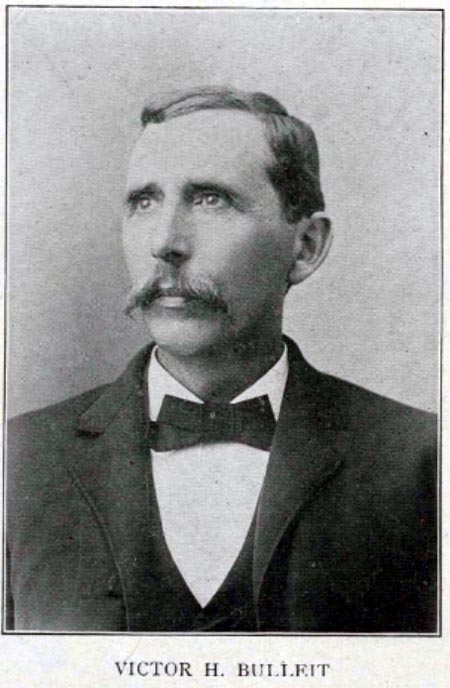
VICTOR H. BILLEIT
comprise the Globe, Hopkins and the
Foster Chemical Company, all of which are favorably
known throughout the country.
FARM AND GARDEN SEEDS.
It is
impossible to raise good crops unless the farmer uses
well developed seeds, and in this line this firm takes
especial pains to secure only the best. Most of
the farm seeds they handle are shipped to them in car
loads from various parts of the country where the best
seeds of each
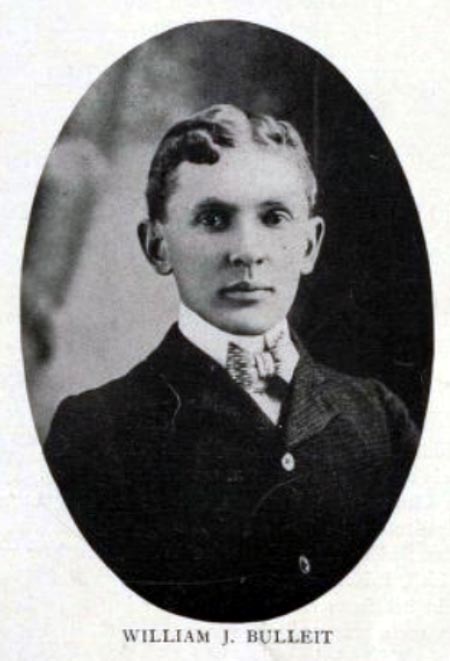
WILLIAM J. BULLEIT
variety are raised. Those
handled in the largest quantities are oats, corn,
potatoes, timothy and clover, each comprising several
varieties. A full line of garden seeds in bulk and
package is also handled.
An immense stock of lime and cement is kept on hand and
sold in any quantity a purchaser may desire.
There are many other articles, aside from those
named, that are handled by this firm which if gone into
detail would fill a book. However suffice it to
state that every need of the farmer is carefully looked
after. |
The business
is conducted in a broad, liberal and conservative manner
of which long experience has been the instructor.
The patronage they receive is fully appreciated and
always rewarded with better business conditions. The
business is transacted in an honorable and upright
manner and so long as V. H. Bulleit's name is
connected with it the people may be assured that the
reputation acquired by this firm will be fully
maintained, and in the future every effort will be put
forth to meet the growing demand of the farmers of
Harrison county for improved agricultural machinery in
their forward march of progress. They employ a
corps of clerks and salesmen who are especially adapted
to their respective positions, among whom we may mention
Robert E. Black, Smith Patterson, Edward Lahue
and Albert Bulleit, who are regularly employed.
V. H. BULLEIT.
The senior
member of this firm, Victor H. Bulleit, son of
Augustus and Mary (Dulieu) Bulleit, was born in
Harrison County, Indiana, Nov. 8, 1848. As a boy
he attended the common schools of the county and was
reared on a farm until he was seventeen years old.
His father dying when he was only ten years old, he was
forced to work his way in the world. At the age of
seventeen he engaged in the blacksmithing business at
New Middletown, Ind., and for eighteen years labored
vigorously over the anvil and forge. Later he
embarked in the implement business with his brothers, in
which he has since continued.
On April 11, 1872, he was married to Miss Mahalia
Johnson, and to them six children have been born,
five of whom - Mrs. Julia Lahue, Mrs. Lula Bruch,
William J., Maggie and Albert J. - are still
living.
Mr. Bulleit owns a farm of ninety-six acres in a
good state of cultivation, on the pike about one mile
east of Corydon. He is a member of the Masonic, I.
O. O. F., K. of P., and K. O. T. M. fraternities, and is
an honest and faithful worker in the ranks of lodgedom.
He has been
the president of the Savings and Loan Association of
Corydon since its organization. He is a
stockholder in the First National Bank of Corydon, and
was one of the organizers and principal promoters.
He is a public-spirited man who always identifies
himself in any enterprise soliciting his support for the
advancement of the best interests of his community.
WILLIAM J. BULLEIT.
William
J. Bulleit, the junior member of the firm, is a son
of V. H. and Mahalia (Johnson) Bulleit, and was
born Sept. 15, 1877. He is a graduate of the
Corydon High School, and this he supplemented with a
business course. He became a full partner with his
father in the implement business on January 20, 1902,
and is bookkeeper for this establishment. He is a
member of the K. of P. and M. W. A. lodges and holds his
membership in the Methodist Church, in which he is a
prominent and faithful worker. He is one of
Corydon's rising and prosperous young men, and is well
known throughout the community for his clean morals,
sterling qualities and business integrity.
FRANK O. JORDAN
Harness and Saddlery
One of the
oldest, best-known and most reliable mercantile houses
in Corydon is that of Frank O. Jordan, who is a
harness maker by trade and conducts a harness store on
the public square just south of the court house.
This concern has been in business in Corydon for the
past twenty-five years, having formerly been operated by
David Jordon, father of the present owner.
Mr. Jordan carries a
full stock of hand-made and hand-sewed work harness,
buggy harness, saddles, whips, lap robes and saddlery
hardware. He does all his sewing exclusively by
hand, and claims that it is impossible to duplicate his
work any other way. Anyhow, his work has always
given perfect satisfaction, which is by the best
recommendation any dealer can have. He also does
all kinds of repair work, and his charges are most
reasonable.
In addition to his stock of harness, he carries a full
line of Dr. Daniel's Horse Remedies, which it is
acknowledged that there is none superior or more
effective in their results.
Frank O. Jordan is the son of David and Agnes
(Farquer) Jordan, and was born at this place May
twenty-five, 1865. On November eighteen, 1890, he
was married to Miss Nell Hudson, daughter of
James and America (Harbeson) Hudson, and to them
seven children have been born. The five living are
Charles, Ray, Allen, Frank and Ruth.
Mr. Jordan is a member of one of the oldest
families in Corydon, and he and Mrs. Jordan stand
high in social circles. He belongs to the
Methodist Church |
|
Pg. 58 - Industrial Review, Biographies
and Portraits of Leading Citizens. |
|
MARTIN & HUFF
A mercantile concern that
reflects great credit upon Morgan township and, in fact,
the whole northern part of this county, is the firm of
Martin & Huff, which is located at Palmyra,
Indian, and the value of having a concern that carry the
stock these people do in a community cannot be
overestimated. In this store can be found
everything needed in the home or on the farm. The
stock carried comprises dry goods, notions, clothing,
hats, shoes, groceries, chinaware, crockery, glassware,
tinware, hardware, harness, agricultural implements,
farmers' tools, farm wagons, surreys, buggies, steel
fencing, stoves, ranges, cooking utensils, clocks,
watches, jewelry, furniture of all kinds and a millinery
department.
In addition to above they handle all kinds of country
produce and pay the highest cash prices therefor.
Space does not permit us to go into detail with an
explanation of the enormous stock carried but suffice it
to say that your wants will be fully supplied at
reasonable prices if you make them known at this store.
Their goods, which are of special selection, are
purchased from the leading and most reliable wholesale
houses and manufacturing concerns of this country and
much of their merchandise is bought in car lots which
makes it possible to undersell their competitors.
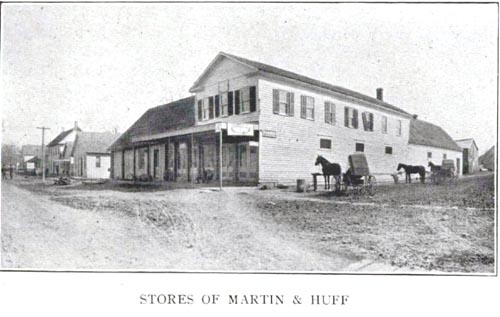
STORES OF MARTIN & HUFF
The following are few
celebrated brands of merchandise they carry: Their
shoe stock comprises the "Hamilton Brown,"
Brown," "Godman," "C. & E." and the
famous "W. L. Douglas." Their clothing is
the "Perfection" and "Ajax," of which there is none
better or more durable or better fitting. The hats
are the "Liberty" and "Anchor" brands, in the latest
colors and styles. They sell the "James and
Meyer" buggies and surreys, which need no
introduction in this county and also the "Old Hickory"
farm wagons. Their ranges are manufactured
especially for this firm from their own designs and are
called "Martin & Huff Ideal." they buy these
ranges in car lots and this is, doubtless, the only
retail store in Southern Indiana that purchases ranges
in this quantity.
the millinery department is conducted by Mrs. W. P.
Huff, who is assisted by an experienced hat trimmer
in season, and here can be found all the latest styles
of hats in every conceivable design and at moderate
prices. This department has just recently been
added, but it is proving to be one of the best
departments of this store.
This firm is composed of John H. Martin and
William P. Huff. Mr. Martin is one of the
county's pioneer merchants, has spent his life time in a
store room and knows the business from "A to Z."
Mr. Huff, the junior member, who purchased his
interest in this store in 1896, is one of the county's
best business men, and his efforts are in a great
measure responsible for the modern condition of this
store.
Both Mr. Martin and Mr. Huff are gentlemen of
very pleasing manners and are always ready to lend their
aid for any good cause or for the betterment of their
town or vicinity. They did a great deal toward
organizing the new creamery which is now in operation,
and also the Citizens' Bank, which will open its doors
about June 1, 1906. The people of this section
should take great pride in this store and show Martin
and Huff that their efforts are fully
appreciated.
CHARLES E. KIRK
Charles E. Kirk, who
conducts the hotel at Mauckport, was born in Posey
township, this county, Nov. 11, 1858, and is the son of
William M. and Elizabeth (Shickle) Kirl He
followed a farmer's life until Sept. 10, 1905, when he
purchased and removed to his present location in
Mauckport, where he conducts one of the best hotels of
the county, and no landlord looks after the comfort of
his guests better than does he.
On July 28, 1878, he was married to Miss Mary,
daughter of William and Isabel (Currant) Jones,
and four children have been born, three of whom are
living, viz: Bertha M., Jesse F., and
Lula D. Beanblossom.
Mr. Kirk owns a fine farm of eighty acres which is
located one mile west of Mauckport. Socially he is
a prominent member of the I. O. O. F. and M. W. A.
lodges. He is one of the leading republicans of
the county and holds his membership in the Methodist
Church.
GEORGE E. BROWN
An establishment that is
worthy of special mention as one of the business
interests of Corydon, is the meat market owned and
operated by M. George E. Brown, who shop is
located in the business part of town, no the west side
of the public square.
Mr. Brown has been in business here for the past
eight years, and buys all kinds of butcher's stock,
"paying the highest market prices," and conducts his
shop that is known all over the city as a place where
the best of everything in the meat line can be procured.
He carries a choice line of fresh, salt and smoked meats
of all kinds, also an excellent line of sausages and
lard, the latter two of which are made on the premises
and are excelled by none. His place of business is
always kept scrupulously clean and neat and the prices
are always very moderate. All orders are are
delivered to any part of the city and every courtesy is
shown to all patrons at all times. |
C. M. MILLER
Of the
various enterprises of Corydon and Harrison County none
stand before the people more conspicuous as an
established business than does the grocery concern of
C. M. Miller, who has successfully conducted the
business for the past twenty-six years and today his
store is replete with the best fancy and staple
groceries and everything used in the culinary department
of the home.
Mr. Miller was born in
Posey Township, Harrison County, Indiana, on July 4,
1843, and at the age of two years removed with his
parents to Corydon and has since resided at this place.
At the beginning of the Civil War he enlisted as
musician in the Twenty-Third Indiana Regiment at the end
of six months the band to which he belonged was
discharged and he immediately re-enlisted as a "private"
in the Fifty-Third Indiana Regiment from which he
received an honorable discharge a year later for
disability.
He served as Deputy County
Clerk under D. M. Jones and in the year 1875, was
elected County Auditor on the republican ticket, which
office he held until 1880.
In 1873 he was united in marriage to Miss Elizabeth
Carr, who has borne him eight children, all of whom
are living.
Mr. Miller is a member of the Masonic and
Knights of Honor lodges and is active and faithful in
church work, holding his membership in the Methodist
Church.
L. S. FLESHMAN.
One of the
most necessary professional men of any community and one
that should be entirely competent is the druggist, and
in this regard the citizens of Mauckport, Indiana, are
certainly fortunate to have such a man as L. S.
Fleshman in this important position. Mr.
Fleshman handles everything in the drug line and
treats his patrons in the very best manner.
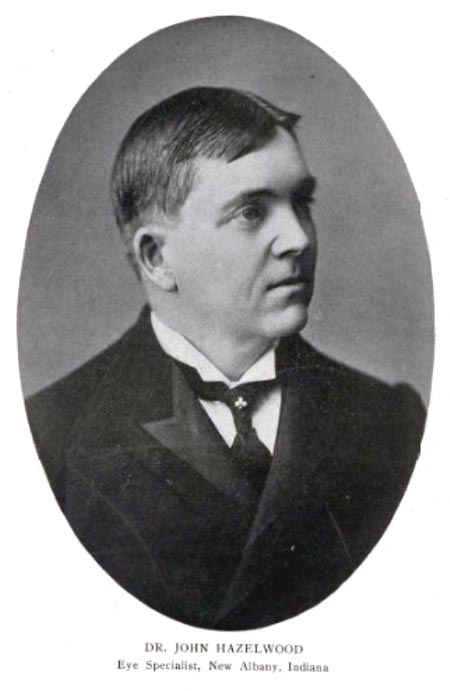
DR. JOHN HAZELWOOD
Eye Specialist, New Albany, Indiana
THE WRIGHT HOTEL
Charles I. Wright, Proprietor
A new hotel
that has recently been opened out in New Middletown and
one that is up to date in all its appointments is that
of Charles I. Wright which began business Mar.
28, 1906. Mr. Wright having formerly
conducted a hotel in Moores Hill, Tennessee, knows just
how to best please his patrons and we predict for him a
prosperous business career.
The hotel building contains nine large rooms and has
just recently been repainted and refurnished throughout
and there is no hotel in the county better prepared to
take care of patrons. He has also a feed stable in
connection with the hotel.
the son of William J. and Emily (Evans) Wright,
he was born near New Middletown, Indiana, on Jan. 19th,
1882. He attended the common schools and later his
education was supplemented with a business course in the
Chattanooga Business College of Chattanooga, Tennessee,
from which institution he holds a diploma.
He was married to Miss Katherine Wolfe, daughter
of Jacob Wolfe, on Feb. 25th, 1906.
Mr. Wright has formerly been a teacher in the
public schools of this county and as such, was entirely
successful. He is an energetic young man of good
morals and deserving of a liberal patronage in his
business.
WHARTON J. BENTON
Wharton
J. Benton, the leading plaster, brick and cement
worker of Harrison County is located at Corydon.
For more than fifty years the name of Benton has
been a synonym for good plastering and it is estimated
that at least seventy-five per cent of the houses now
standing in Corydon were plastered by Bentons. |
DEPAUW ROLLER
MILLS
The Depauw
Roller Mills, which is the leading manufacturing concern
of Depauw, was erected in the year of 1902 and opened
for business in the month of August. The building
comprises two stories and a basement 30x50 feet and an
engine room 18x30 feet attached. The mill is
equipped with four double stands of wheat rolls and a
corn roll and has equipped with four double stands of
wheat rolls and a corn roll and has a capacity of sixty
barrels of flour per day. their brands of flour
are the "Drifted Snow" and "People's Choice. "
this mill furnishes the home market and surrounding
towns with their breadstuff and the balance is shipped
to Louisville, Kentucky, where they find ready sale for
their entire output.
The mill is owned by M. Schuppert, who is in
business in Louisville, Kentucky, but is operated by his
sons John, who is a practical miller.
John Schuppert was born in Germany, Aug. 15, 1868,
and came to America with his father in 1884. He
was married to Miss Edith Stone of Clark County,
Indiana, in September, 1894, and to them have been born
four children, three of whom are living.
John is one of the best millers in the county,
having followed this vocation a life time and is
honorable and strictly honest in his dealings.
KELLER MANUFACTURING COMPANY
The largest
and most worthy enterprise ever launched in Corydon or
Harrison County is the Keller Manufacturing Company, and
this concern deserves great credit for the advancement
of Corydon in the commercial world.
This company is engaged exclusively in the manufacture
of "Corydon" and "Keller" farm wagons, farm trucks and
log wagons, and has established a trade for these well
known makes from Kansas to New York and from Michigan to
Texas.
The factory, including buildings and lumber yards,
covers about ten acres of ground. The buildings
are substantially constructed and are built of both
brick and frame.
The factory consists of saw mill, dry kilns, lumber
sheds, wood working department, blacksmith shop, paint
shop, stock room, assembling ware room, power house,
spoke mill and offices.
The saw mill is 40x80 feet and is equipped with
machinery to utilize every part of the log.
The wood working department occupies a building 80x160
feet and is equipped with the most modern wood working
machinery, in which all wood parts of a wagon are sawed,
turned, shaped, planed and fitted together. This
department is fitted together. This department is
fitted with a "blowing" system in which all shavings and
offals are automatically gathered up and carried
in large metal tubes to the boiler-rooms where they are
utilized for fuel.
The blacksmith shop is 60x80 feet and, as are the other
departments, is equipped with all the necessary
machinery and tools used in this branch of the factory.
An interesting department of the factory to one not
accustomed to the workings of a plant of this nature is
the paint shop and the manner in which a wagon is
painted. Here the various parts of the wagon
receives first a coat of oil by being dipped into a
large tank or vat
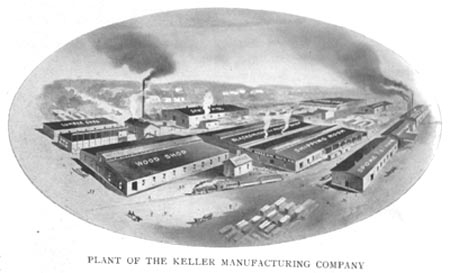
PLANT OF THE KELLER MANUFACTURING COMPANY
which is about seven feet deep and of
sufficient dimensions to allow any part to be dipped
into it. Next comes the priming coat of paint, the
same process being used, and after this coat of paint
becomes dry another coat is applied in the same manner.
The third coat of paint and the varnish coat is put on
with a brush.
The ware rooms, in which the complete wagons are stored
to await shipment, are 80x120 feet and 60x120 feet and
in this department every piece of the wagon goes through
a most rigid inspection.
The spoke mill is 60x120 feet and contains all
machinery necessary to complete a spoke ready to go into
the wheel.
The power house is supplied with a battery of two large
boilers and three engines of 320 horse-power are
required to operate the plant.
The Keller Manufacturing Company is incorporated for
$100,000 with William H. Keller, President, T.
J. Hudson, Vice-President, L. C. Keller,
Treasurer and E. G. Keller Secretary and General
Manager.
The company was organized in 1894 and first engaged
only in the manufacture of spokes and wagon material,
but in 1900 the factory was enlarged and the necessary
machinery installed for the building of a complete wagon
from the crude material. The plant gives
employment to about one hundred men and has an annual
capacity of about 5,000 complete wagons.
The "Corydon" and "Keller" wagons, the product of this
concern, have proved durable, reliable and satisfactory
to the trade in all respects and those goods are in
constant demand.
This is one of the leading concerns of its kind in the
State and enjoys a high rating in the commercial world.
|
|